10 Excellent Day Trips From Portland, Oregon (Local’s Guide)
If you’ve read our guides before, you’ll know that one of our favorite things about living in Portland is that we’re within a short drive – roughly 90 minutes – of the Pacific Ocean and the mountains (the Cascades, mostly).
Within 90 minutes, you can get from Portland to alpine terrain with up-close-and-personal views of Mount Hood, coastal bluffs with never ending vistas of the Oregon Coast, or a barren landscape shaped by a volcanic eruption that changed the surrounding area forever.
We’re lucky to call Portland home, and we want to share our favorite places within 90 minutes with you so that you can fall head over heels in love with Oregon like we have.
Whether you’re just in town for a couple of days, or you live here and are looking for some new ideas, we’re here to help you plan your next outing.
In this guide, we’re going to give you our perspective on the best day trips within two hours or so of Portland, whether you’re looking for a charming town to visit or want to see one of Oregon’s incredible waterfalls (or ten of them – spoiler alert).
We’ll give you our favorite day trip destinations, along with the things you need to know to plan your trip – like how to get there, whether you need a car or not, and some of the best things to do while you’re there.
Sound good? Let’s get into it!
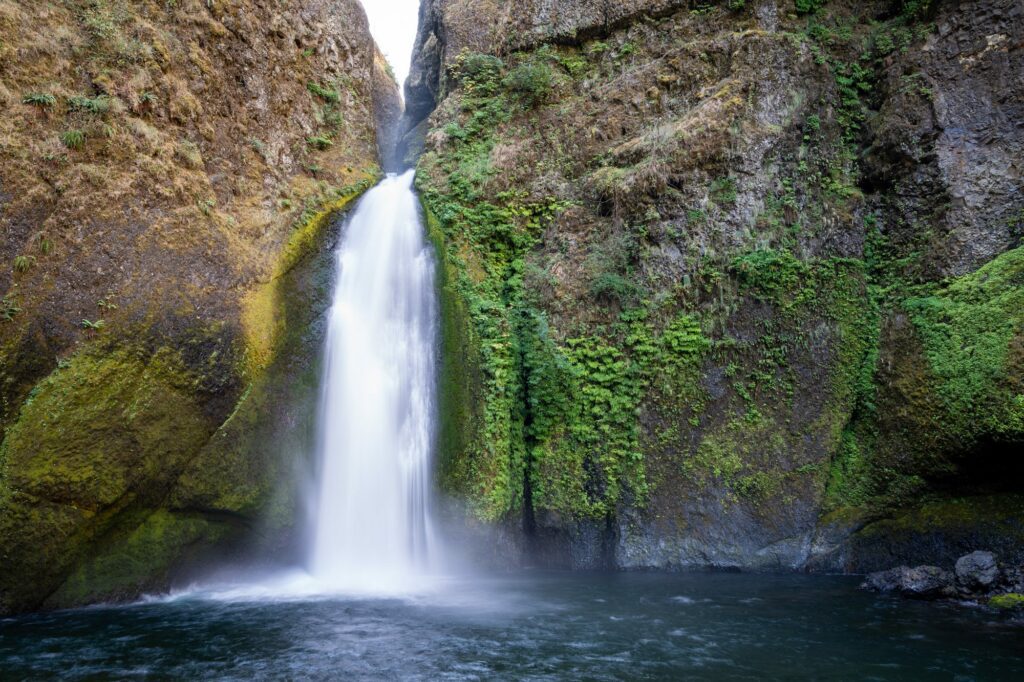
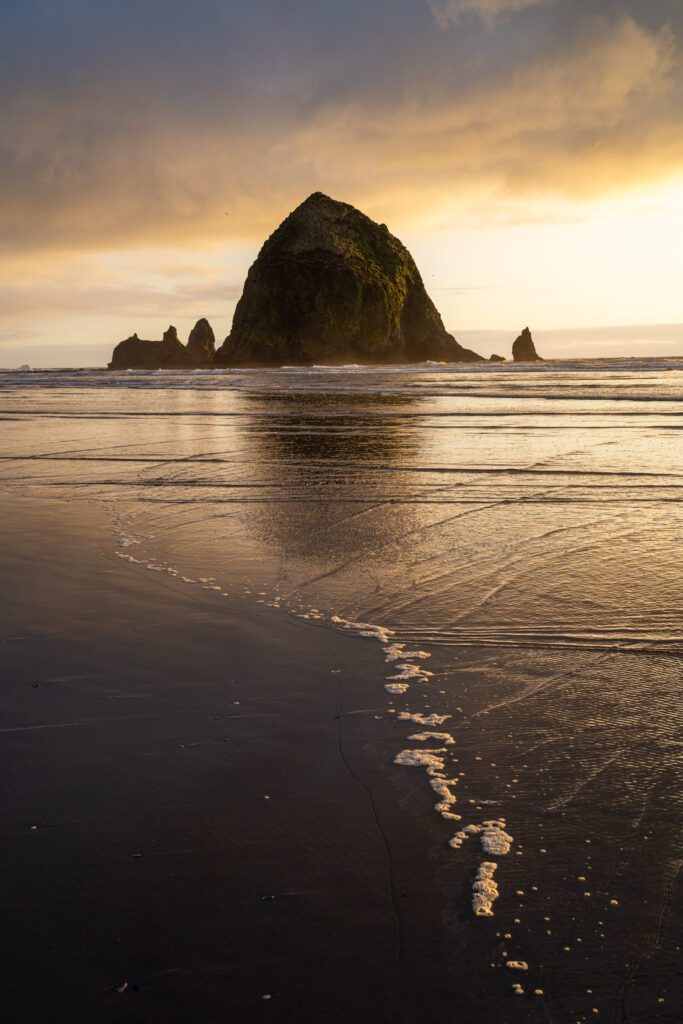
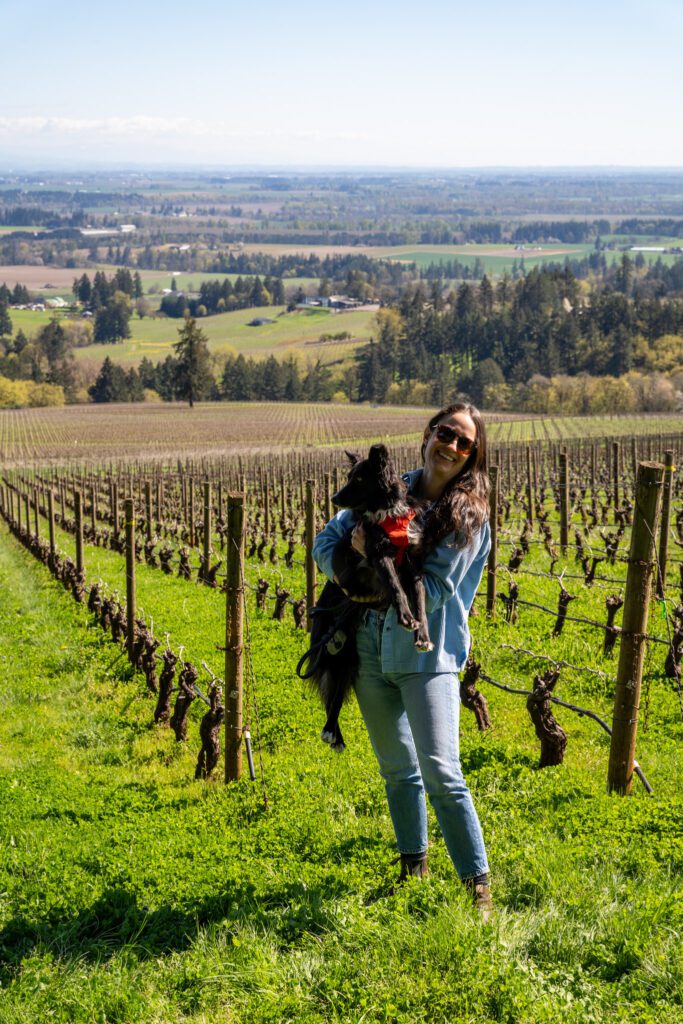
Disclaimer: Some of the links in this post, like hotel links, are affiliate links, meaning at no additional cost to you, we make a little bit of money if you click through and book. That being said, we would never recommend something to you that we don’t stand behind 100%.
Our 10 Favorite Day Trips from Portland, Oregon
In this guide, we’re going to cover our favorite day trips, along with some of the important details you’ll need to know to plan your trip (like how to get there and what to do).
We’re only including day trip destinations that are within about two hours of Portland here – anything over that is probably better as a weekend trip to make the drive time worth the journey.
In general, you are going to need a car to reach the vast majority of the places we’ve included below.
The few public transportation options that do exist just aren’t that useful, especially if you want to get out of town to go on a hike (we usually do) or visit a winery.
That being said, there are a couple of places you can reach by public transportation or a guided tour, so we wanted to include a quick blurb which of these day trips would be good if you don’t have access to a car.
Here are a couple of options if you don’t have a car.
The easiest day trip to reach without a car is going to be the Columbia River Gorge, which is accessible both by shuttle (though you need to get to the first shuttle stop, which will require a long rideshare) and by guided day trip (this half day tour is our recommendation).
There are also guided day trips that will take you out to Cannon Beach and the surrounding area on the Oregon Coast (this is the one we’d choose).
While you’re certainly going to have less flexibility in terms of what to do and see, you’re also going to get to spend some time with a local who can give you a little more insight into the places you’re visiting than you might get on your own.
Sauvie Island
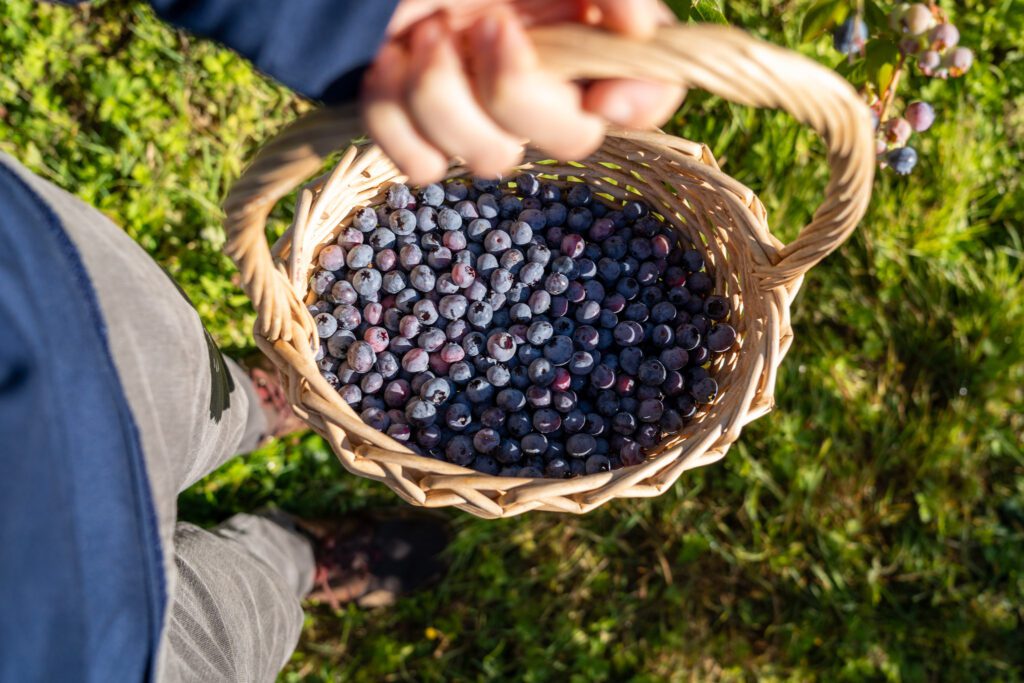
Distance from Portland: 19 miles || Drive Time from Portland: 35 minutes
Sauvie Island is the most accessible of the day trips in this guide, and we are often surprised at how fast you go from city to rural as you drive up Highway 30 north out of Portland and cross the bridge onto the island. It’s an immediate shift, more or less.
We like Sauvie Island for one main reason: the farms. Especially in the early summer, when the u-pick berry fields are ripe for the picking.
What to Do on Sauvie Island
What to do once you’re out on Sauvie Island is very much a seasonal thing, because different seasons highlight different aspects of Sauvie.
For what it’s worth, the summer – particularly early summer during berry season – is our favorite time to be out here, and we make at least one trip during that timeframe.
U-Pick Farms (Summer and Fall)

Every summer, we make the journey out to Sauvie Island for u-pick berry season (usually strawberries or blueberries), where we often spend an hour out in the fields picking and end up with an entire flat of berries for ~$30, which would cost $50+ at the farmers market (more at the grocery store).
This past season, we went out to pick strawberries with a strict half flat policy (because strawberries don’t hold up too well after being frozen), and came home with an entire flat because it was just too good a deal.
Which resulted in Matt sitting on the couch eating the last pint of strawberries with tears running down his face because it was about to go bad, and he didn’t want to waste them (Alysha was out of town).
Anyway, there are several places to go pick fruit throughout the summer (and it becomes pumpkins and corn in the fall). Here are three of our favorites:
Columbia Farms U-Pick: Our go-to spot for strawberries, though they also have raspberries and more. They have a bunch of unique varieties, and we liked picking pints of each and comparing them.
Croft Farm: We go here for blueberries, and it’s a lovely property and great value.
Topaz Farm: A wide range of u-pick berries in June and July, then tomatoes, then pumpkins as you get into fall.
The Warrior Rock Lighthouse (All Seasons)
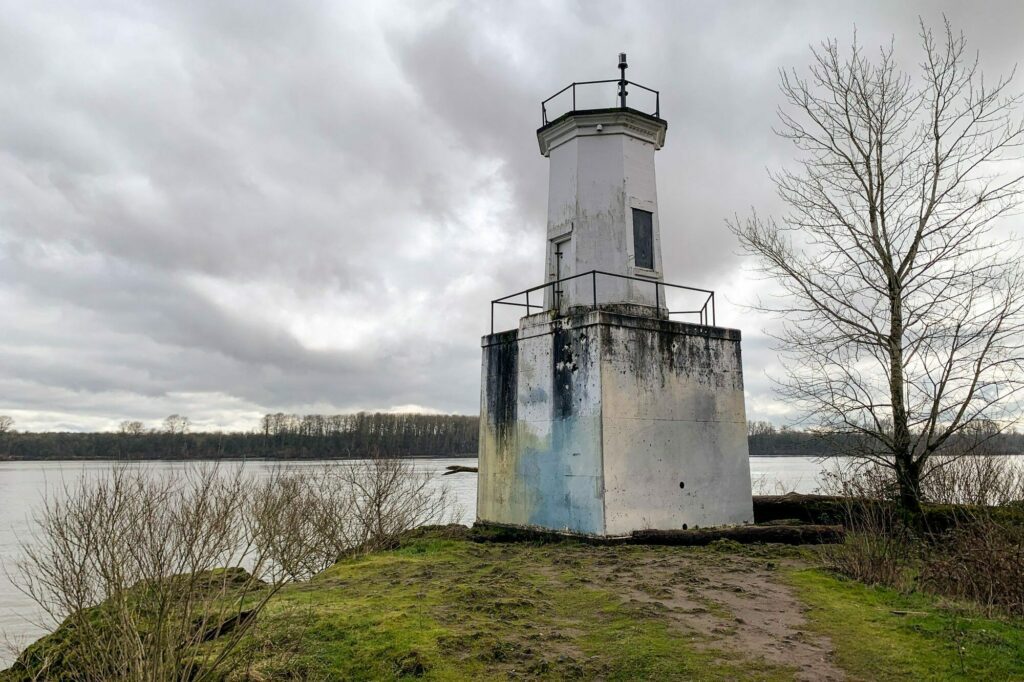
This hike at the northern end of the island takes you out to a nice sandy beach on the Columbia, and a squat little lighthouse looking out over the Oregon-Washington border.
The trail itself is basically flat, and you’ll need to pick up a parking permit on your way out to park at the trailhead (they cost $10 for the day – more information here).
It’s worth noting that, while we say it’s all seasons, we like this hike in the winter because it’s accessible (if not a bit muddy), and the bare trees mean you can see all sorts of fun birdlife, particularly bald eagles.
The Columbia River Gorge
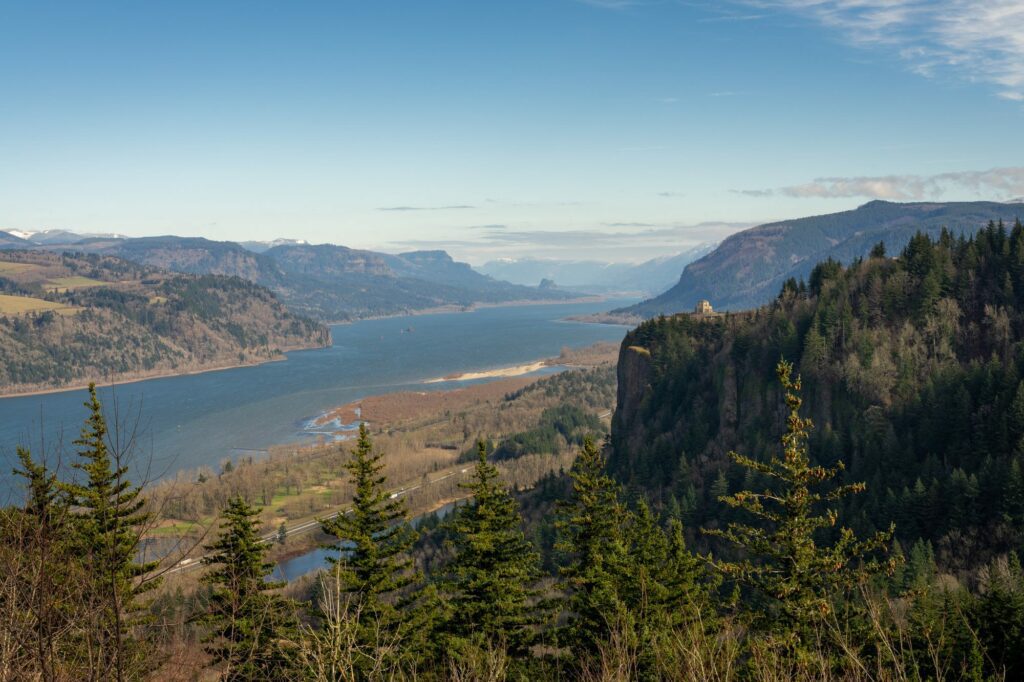
Distance from Portland: 30 Miles || Drive Time from Portland: 40 Minutes
The Columbia River Gorge is BARELY a day trip considering it takes about a half hour to get from the city center to the western end of the Gorge. Which is why it’s near the top of this list.
This might be a hot take, but I’m not sure there’s a day trip from any city in the country that rivals the Columbia River Gorge in terms of accessibility from the city center and pure natural beauty.
The Columbia River is the river that Lewis and Clark followed west to the Pacific Ocean, and it flows east to west across the northern edge of Oregon, marking the border between Oregon and Washington State.
The part we’re talking about here is the stretch between Hood River and Portland, which is a lush paradise that features both some of the best hikes in Oregon and multiple of our favorite waterfalls in Oregon.
The natural beauty on display in the Gorge is astounding, and it’s our number one recommendation if you’ve never been before.
What to Do in the Columbia River Gorge
Here are some of our favorite things to do in the Columbia River Gorge, in no particular order.
See Some Waterfalls
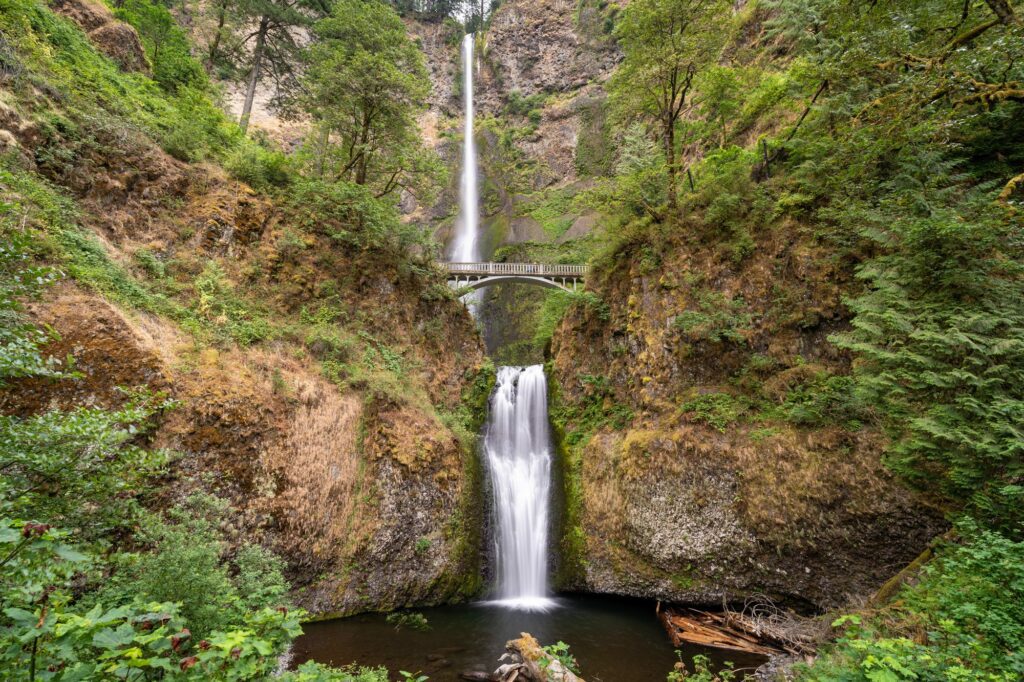
I mean, this has to be number one.
There are an astonishing number of beautiful hikes in the Gorge that end in a spectacular waterfall, some of which are basically right off the side of the road, some require a little bit of a hike.
Here are four that we love (this is by no means an exhaustive list, though!):
Multnomah Falls: The crown jewel of the Gorge, and also the most popular waterfall in the area. It’s impressive, but the crowds are oppressive. We’d recommend coming here as early as humanly possible and doing the lower viewpoint and the short hike to the upper viewpoint on the bridge, then moving on. Heads up: you need a permit during peak season in 2024 (more information here).
Latourell Falls: The lower falls is more impressive, and is basically visible from the parking lot. But you should definitely walk down to the base of the falls, and then do the short loop that takes you up and around to the upper falls.
Horsetail and Ponytail Falls: A relatively new discovery for us, both waterfalls are spectacular. Horsetail is the lower falls, which is right across the road from the parking area. Ponytail requires a short hike to access – it’s surprisingly tough for how short it is – but is well worth the effort because you can walk behind the falls.
Dry Creek Falls: A less-visited waterfall that follows part of the PCT on the way to a nice waterfall that sees a tiny fraction of the visitors to the three above. Trail information here.
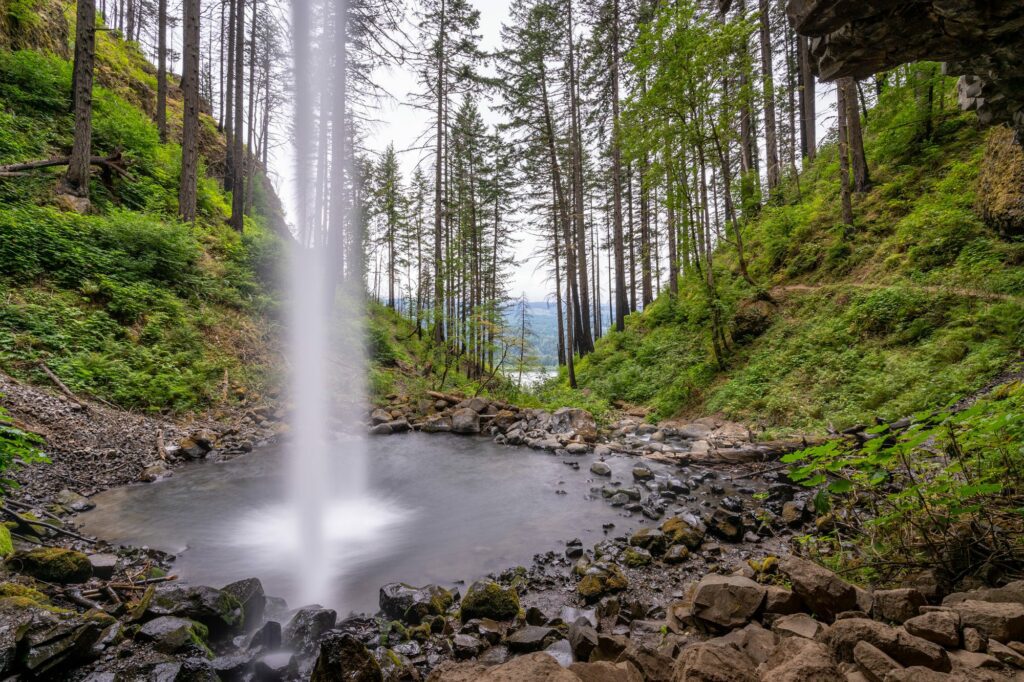
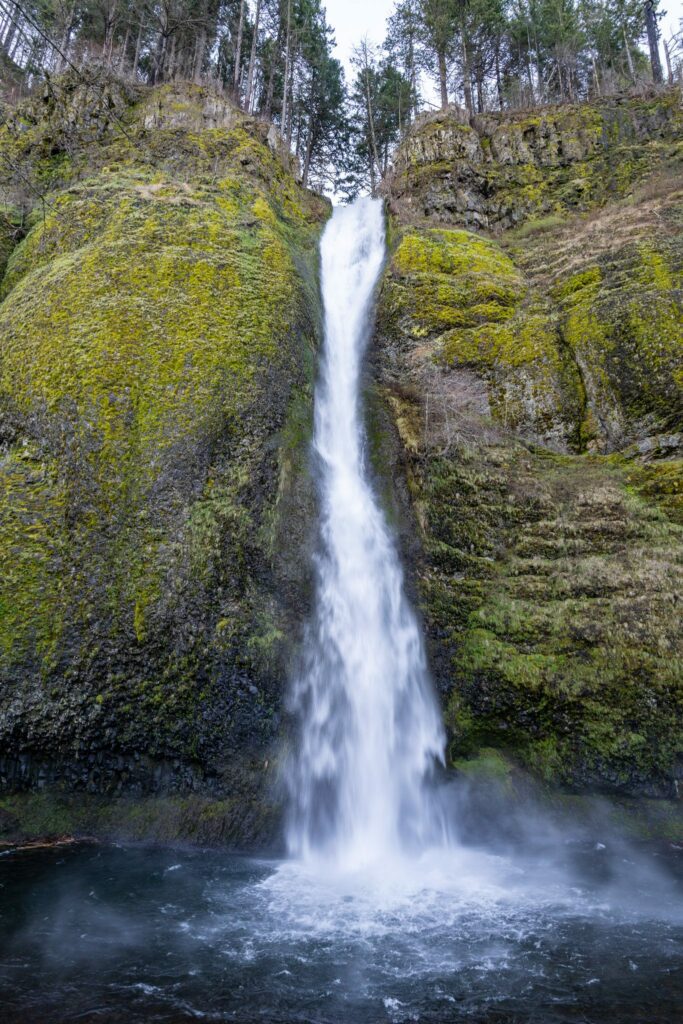
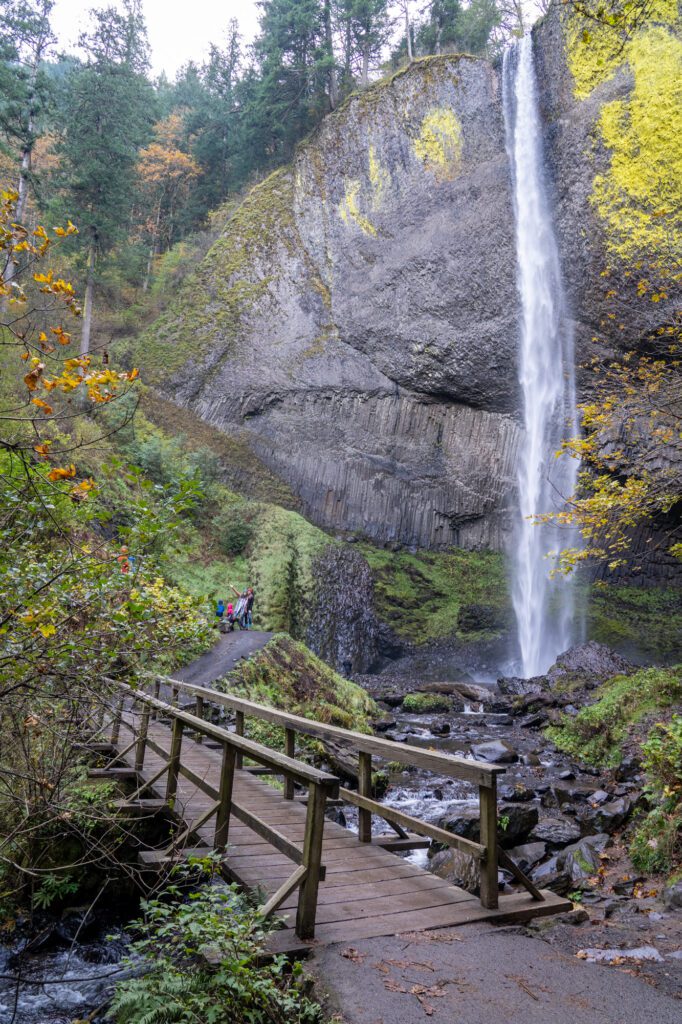
Get Some Epic Views of the Gorge
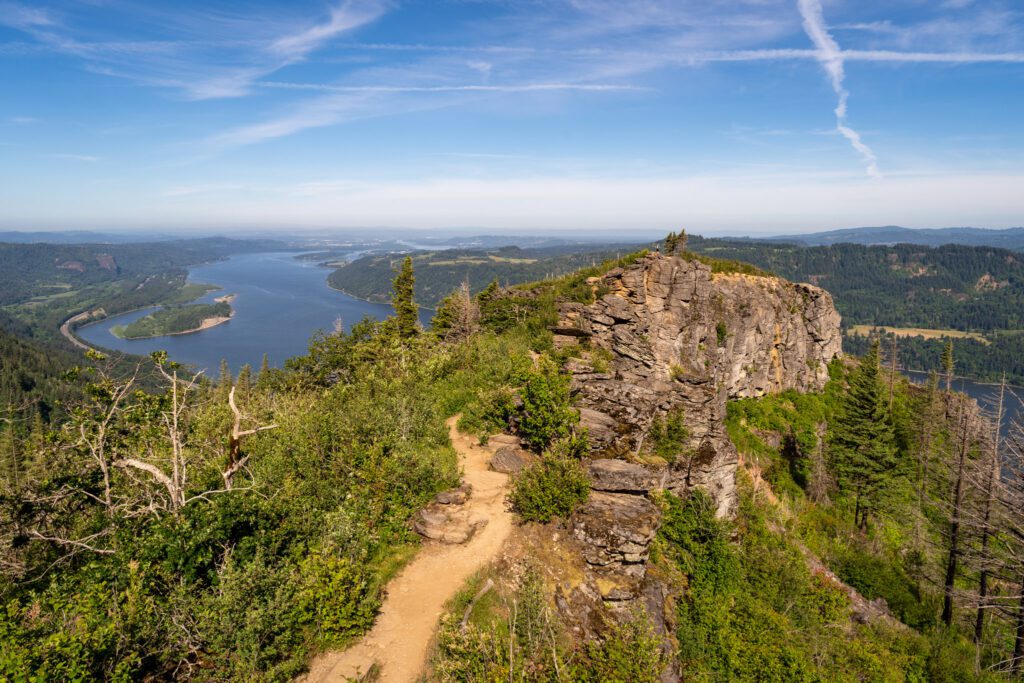
There are two varieties of views of the Gorge. Those that you can see right from the parking lot, and those that you have to put a little sweat in to reach.
For great views from the parking area, head to the Women’s Forum Scenic Viewpoint and the Vista House on the western end of the Historic Columbia River Highway.
For hikes that end with a view, do Angel’s Rest or Larch Mountain.
Get Over to the Washington Side of the Gorge
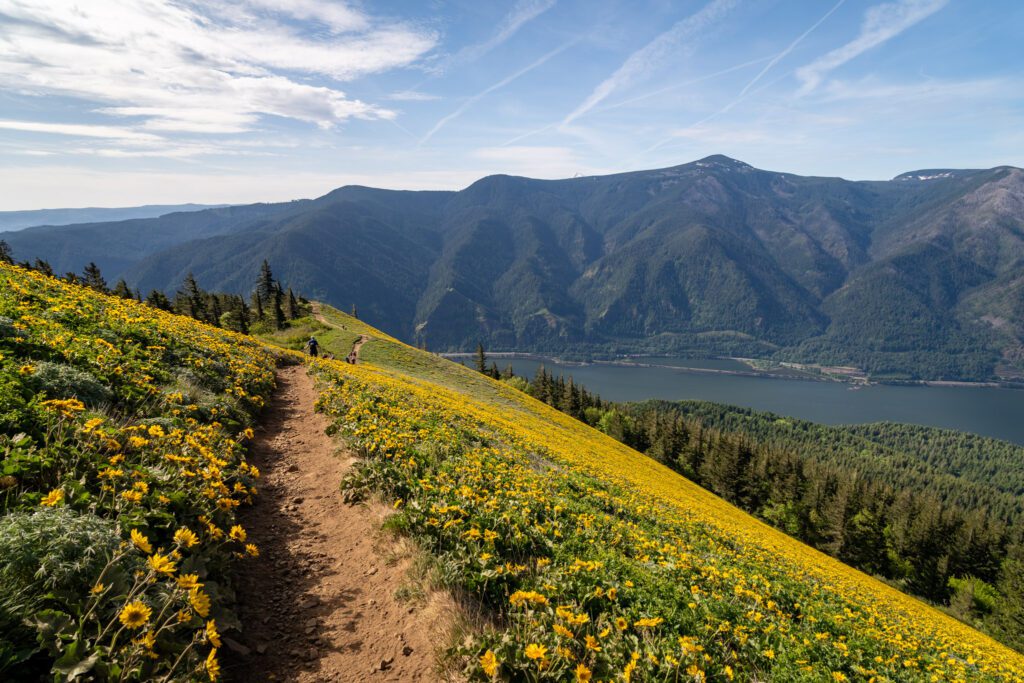
To this point, we’ve largely covered the Oregon side of the Gorge, but there are absolutely things to see on the other side of the Columbia River, particularly if you’re into hiking and great views.
We like the views from the Cape Horn Trail and the wildflowers at Dog Mountain and Coyote Wall.
If you’re willing to go a little further, Panther Creek Falls and Falls Creek Falls are also pretty spectacular.
The Willamette Valley
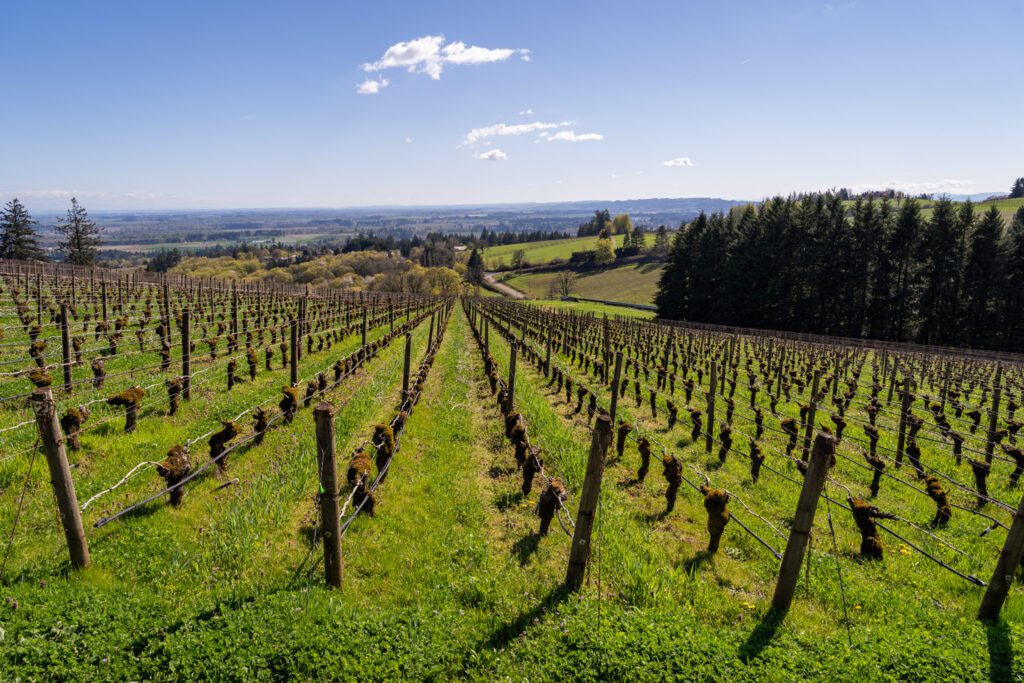
Distance from Portland: 50 miles || Drive Time from Portland: 1 hour 10 minutes
I’m going to be honest, I didn’t quite realize just how great the wine coming out of the Willamette Valley was until I was in Burgundy, one of the most prestigious wine regions in the world (in southeastern France).
Now, my experience abroad with people knowing where Portland, Oregon is has been a little hit and miss.
Some people are in on the secret (oddly, a lot of people immediately talk about Dame and the Blazers, Portland’s NBA team), some people don’t have any idea what I’m talking about.
In Burgundy – and I want to emphasize that this is one of the world’s most prestigious wine regions – I had multiple experiences where I told people I was from Portland, Oregon and saw their face immediately light up and say “oh yes, the Willamette Valley!”
It blew my mind, and it turns out there are multiple layers around why Burgundians might know the Willamette Valley.
The climates are similar, which means they grow the same varietals (pinot noir and chardonnay, mostly).
And for that reason, several French producers immigrated to the Willamette Valley and began the process of making it one of the best wine regions in the country.
Now, one of our favorite things to do in Portland with out of town visitors is to have them try Willamette Valley chardonnay, which is, as we like to say, not your mom’s friend’s chardonnay.
We aren’t fans of buttery, oaky chardonnay AT ALL, but the chardonnay coming from the Willamette Valley is often more fresh, light, and crispy, with relatively little new oak being used.
Now, the Willamette Valley is a big area (that actually encompasses Portland). Which part should you focus on?
If we were you, we’d focus on the area roughly between McMinnville and Dundee on the north end of the valley.
The valley continues south, and there are some great tasting rooms down that way (we LOVE Johan Vineyards), but the best bang-for-your-buck is going to be around those two towns.
This is one of the few day trip options where there are options to do it without a car.
And because the highlight here is wine tasting, it might actually make sense to do a guided day trip so that your whole party can indulge freely without needing to appoint a designated driver.
After a few wine tasting trips, Matt has become an expert at spitting into the stainless steel containers they have for designated drivers (after being unbelievably bad at it on the first trip).
There are several guided tours of the Willamette Valley, and we went through the options to figure out which one we’d actually choose if we were doing it ourselves.
We landed on this tour, which is run by an Oregon-based company that focuses exclusively on wine tours.
What to Do in the Willamette Valley
Here are a few of our favorite things to do in the Willamette Valley if you’re around for a day trip.
Wine Tasting in the Willamette Valley
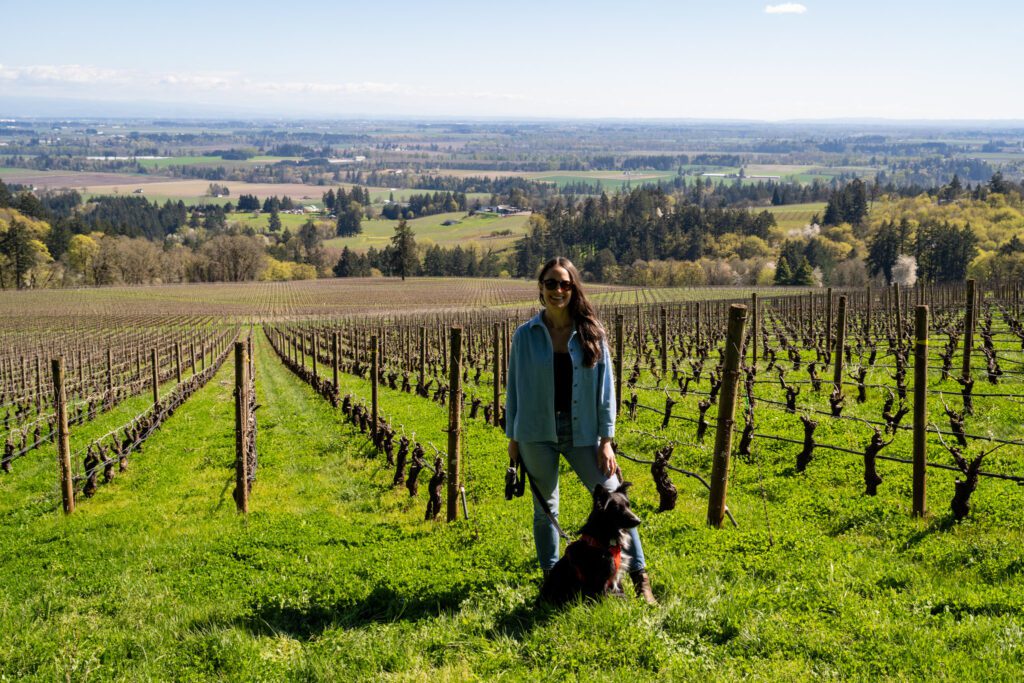
The first and most obvious thing to do in the Willamette Valley is go wine tasting, so that’s what we’ll cover first.
As we mentioned above, the best area in terms of concentration of wineries is the area around McMinnville and Dundee right along Highway 99.
Here are a few options in that neck of the woods.
Day Wines: One of our favorite wineries, this is a very approachable tasting experience. Day Wines is all about drinkable wines, and I like that they take some of the pomp and circumstance out of wine tasting.
Domaine Drouhin: This place is interesting because it was started by one of those French immigrants to the valley, and they actually have a sister winery over in Burgundy.
Their tasting room is available by appointment, and their whole thing is “French soul, Oregon soil,” which is a unique approach. They also have tasting experiences that include tasting their Oregon wines next to the French wines, which is cool.
We recently visited and spent two hours on their (dog-friendly) patio enjoying a deep dive into the differences between their Oregon and French wines, and enjoyed it.
Argyle: If you want bubbles – and we almost always do – this is the place to go. They’re known for their bubbles, and they have a nice tasting room in Dundee.
Explore Downtown McMinnville
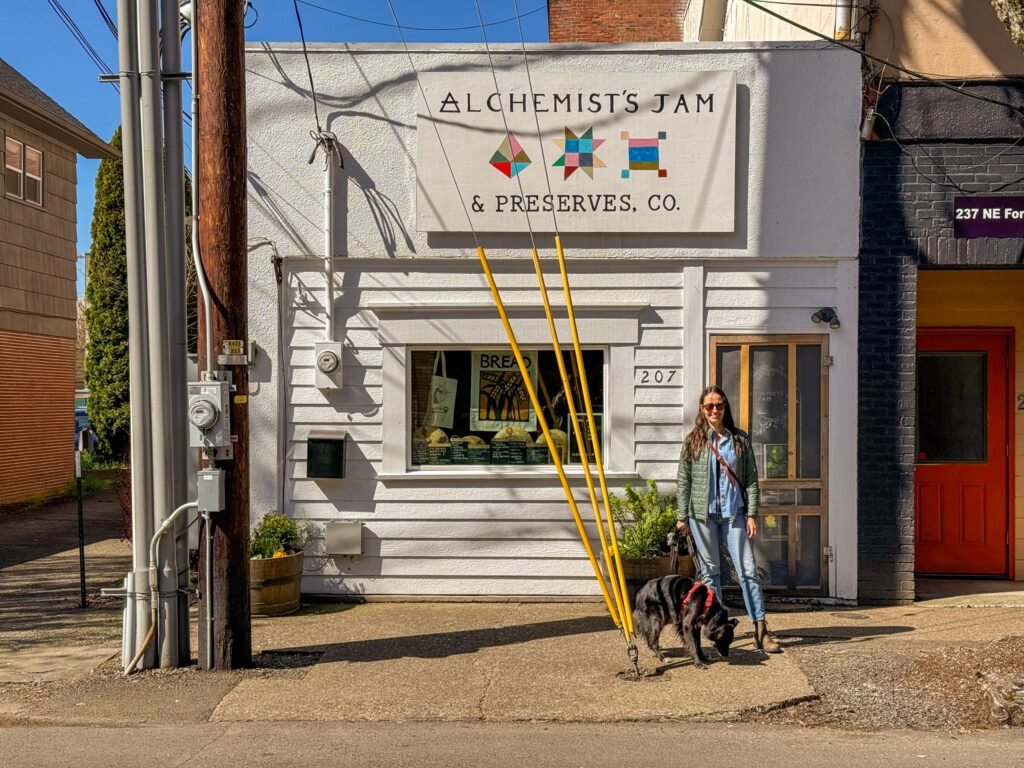
The heart of McMinnville is NE 3rd Street, which is where 90% of the action is for your purposes. It’s a 3-4 block stretch that has a nice selection of shops, coffee shops and bars, and restaurants.
We always stop into Third Street Books and Alchemist Jam (who makes our favorite jams in the state that are in 90% of our Christmas gifts to friends and family and has a lovely little bakery in McMinnville).
Plus, if you’re gluten free (like Matt, who has Celiac Disease), there’s a 100% gluten free brewery and pub – Bierly Brewing – with excellent fresh fried doughnuts on weekends.
Flag & Wire is the best coffee spot in McMinnville.
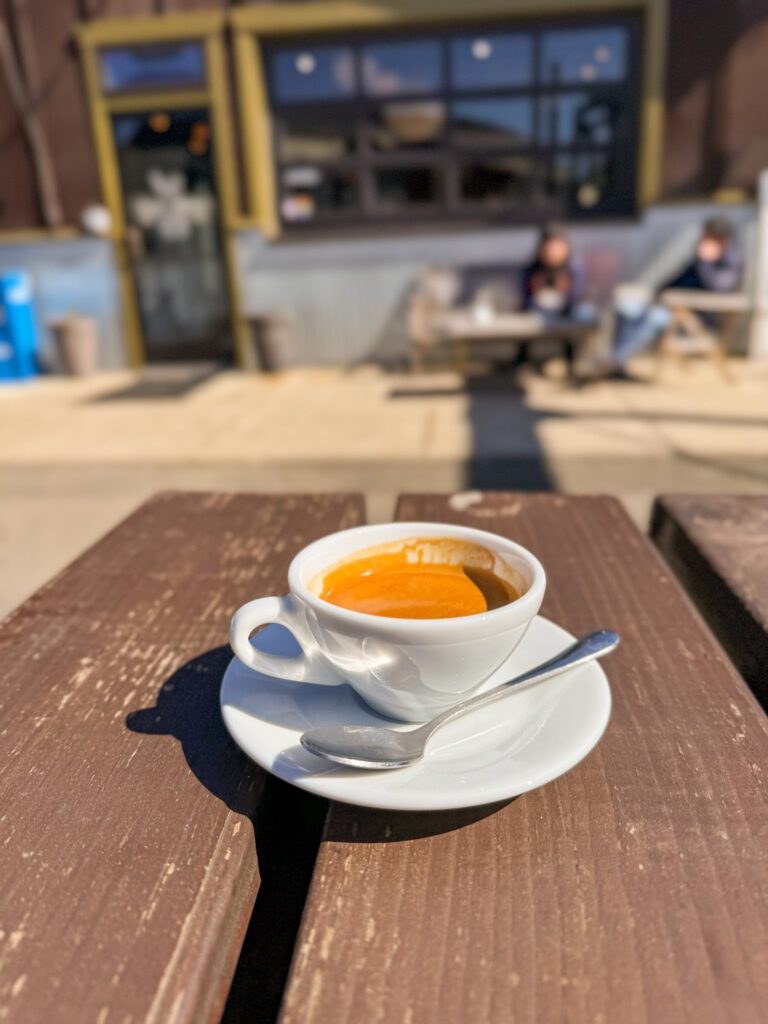
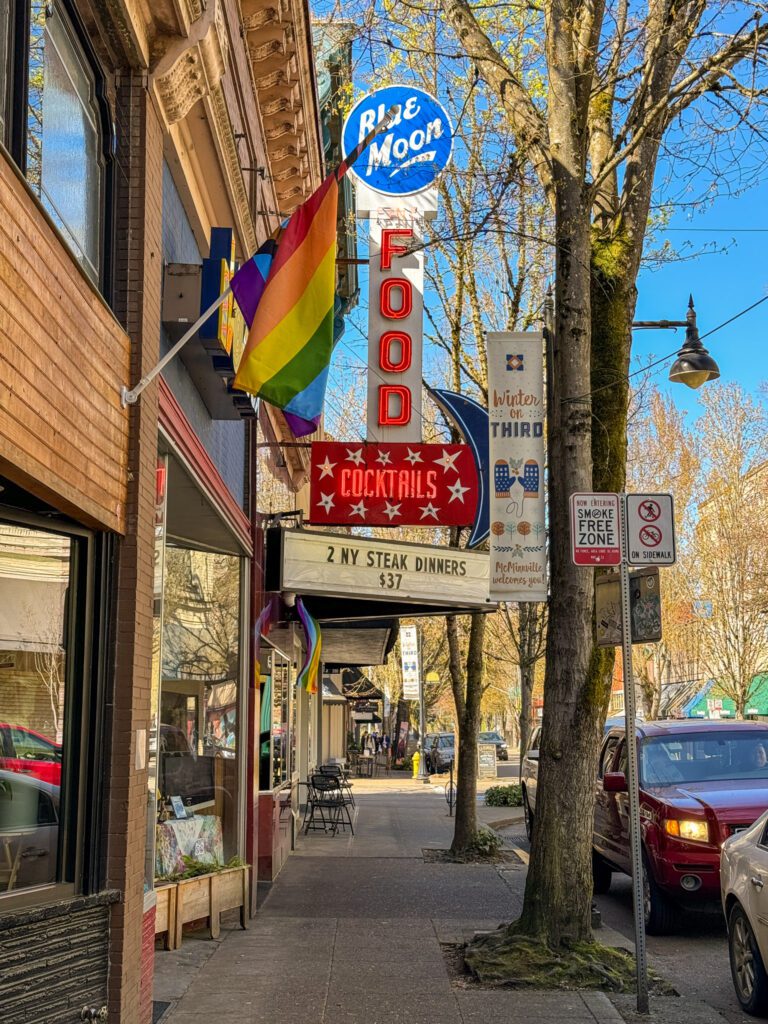
Head South from McMinnville
As we mentioned above, there is some good stuff as you head south from McMinnville.
In particular, we love Art & Science Wine + Cider, which is down in Shipley, and the aforementioned Johan Vineyards.
Left Coast Cellars is along the same road as Johan, and is also worth a stop.
Silver Falls State Park
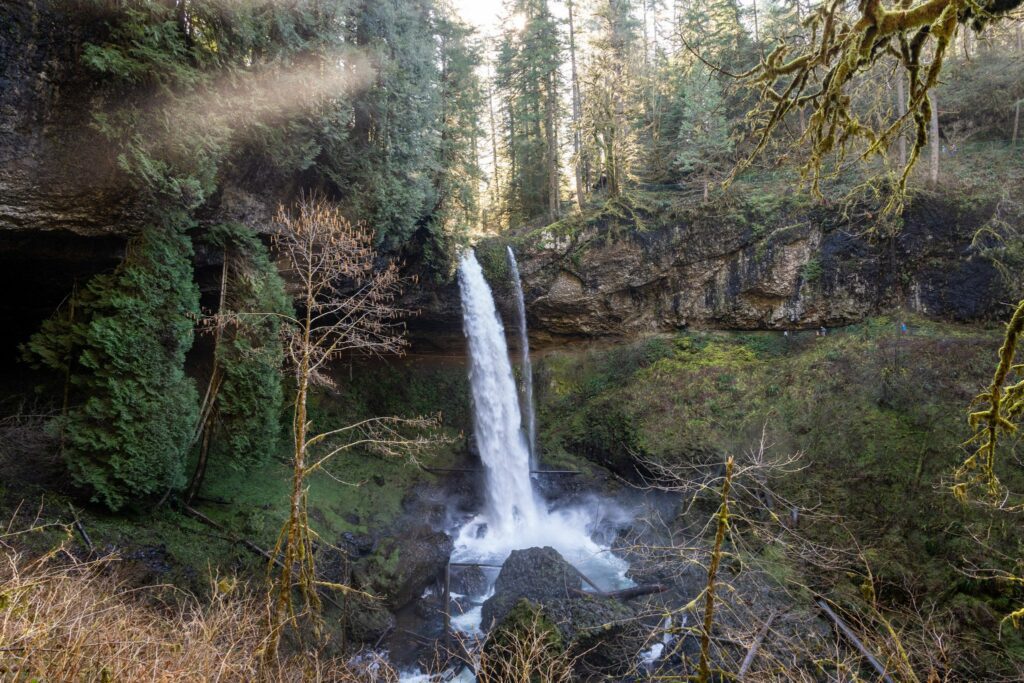
Distance from Portland: 55 miles || Drive Time from Portland: 1 hour 15 minutes
If you’re in the mood for waterfalls, then there are two places to see in Oregon that you shouldn’t miss.
We already covered one of them above – the Columbia River Gorge – and the second one is Silver Falls State Park, which is about an hour south of the city near Salem.
Silver Falls State Park is the biggest of Oregon’s state parks, and the highlight here is the Trail of Ten Falls.
The concentration of waterfalls along this trail is mind boggling, and while you can see the towering South Falls from the parking lot, we’d highly, highly recommend hitting the trail to see all of them if you can.
What to Do in Silver Falls State Park (& Around)
There’s really only one thing to do in the park, and that’s the spectacular Trail of Ten Falls, which is near the top of our list of the best hikes in Oregon.
It’s going to take you about a half day or so, and is well worth the journey.
Hike the Trail of Ten Falls
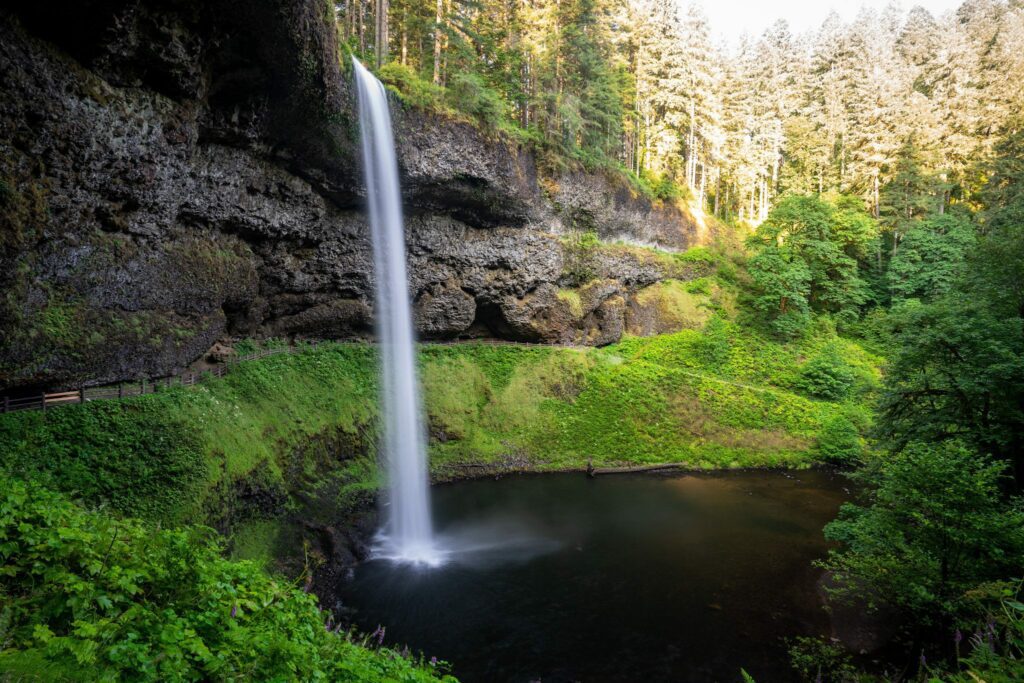
The hike is exactly what it sounds like. A trail. With ten falls.
It’s not a particularly difficult hike in terms of elevation gain, but it is a little bit long.
Start at the South Falls, which might be the most impressive waterfall of the bunch, and make your way clockwise, which means you’ll see the vast majority of waterfalls on the first half of the loop.
Make your way out to North Falls – and don’t miss Upper North Falls – and then take a leisurely walk along the rim back to the parking lot.
This park gets super busy, so we’d highly recommend getting an early start, particularly on a weekend. Even better is to visit on a weekday, but not everyone has that kind of flexibility.
For far more information than we’ve fit into this summary, you can head over to read our trail guide for the Trail of Ten Falls, which has everything you need to know to hit the trail.
Other Worthwhile Stops Near Silver Falls
After your hike, there are a couple of stops nearby that are worth your time.
First is Salem, which is the capital of Oregon. It’s about a half hour west of the park, just across I-5.
The Willamette Heritage Museum is worth a stop to learn about the history of the region as a whole, and we love Bigwig Donuts (for donut holes) and Xicha Brewing (for tacos and beer). All the flavors!
Second is Abiqua Falls, another waterfall that makes our list of the best in Oregon.
Unfortunately, it’s not super convenient to get there from Silver Falls because you have to go out and around to access it from the north, but if you’re already down here, it’s worth the add-on.
Third are the farms in the eastern Willamette Valley – E.Z. Orchards and Bauman’s, both of which make excellent cider.
There’s also u-pick everything (mostly berries) in the summer at Fordyce Farms.
Mount Hood
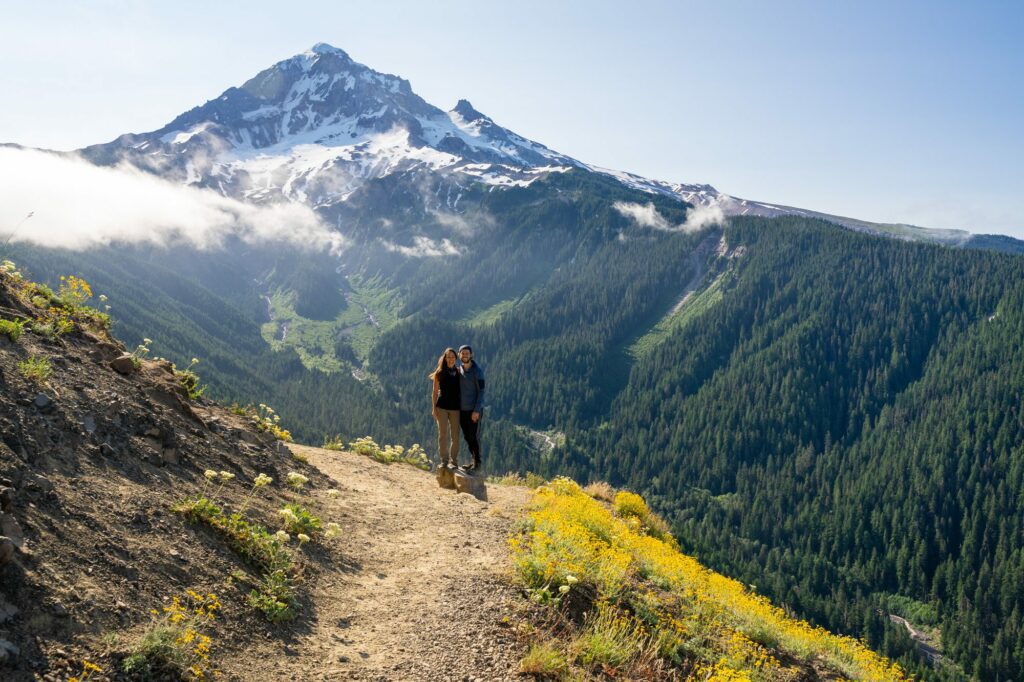
Distance from Portland: 56 miles || Drive Time from Portland: 1 hour 20 minutes
One of the things we love about living in Portland is the fact that you’re always just 90 minutes away from both the coast and the Cascades.
Given the choice, we’re choosing the mountains over the coast ten times out of ten, and we’ve found that being 90 minutes from Mount Hood is one of our favorite parts about living in Portland.
In the summer, Mount Hood is one of the best hiking destinations in Oregon, and the broader Pacific Northwest.
From various hiking trails around Mount Hood, you’ll be treated to unbeatable views of Hood’s snow capped peak, meadows of blooming wildflowers, beautiful waterfalls, and more.
It’s essentially paradise for alpine hiking enthusiasts like us.
If you like hikes that end with amazing views of a snow capped peak and/or skiing down slopes with an unobstructed mountain view, you’re going to love Mount Hood.
Driving is the best way to get from Portland to Mount Hood, particularly in the summer when there’s no public transportation option that will take you to trailheads, as far as we know anyway.
The Mount Hood Express runs from the town of Sandy, which is along Highway 26 on the way up to Hood, to various stops near Government Camp.
However, you have to get yourself to Sandy, which is going to make it a very long, potentially very expensive trip. It’s only $2 each way for the bus, though, which is nice.
If you’re visiting in the winter, there’s a shuttle run by Mount Hood Meadows that will pick you up in Portland and take you up to the resort for a day of skiing without having to worry about driving and parking.
What to Do at Mount Hood
Summer in Mount Hood – which is essentially July through mid-October for our purposes – is all about hiking.
Hiking at Mount Hood
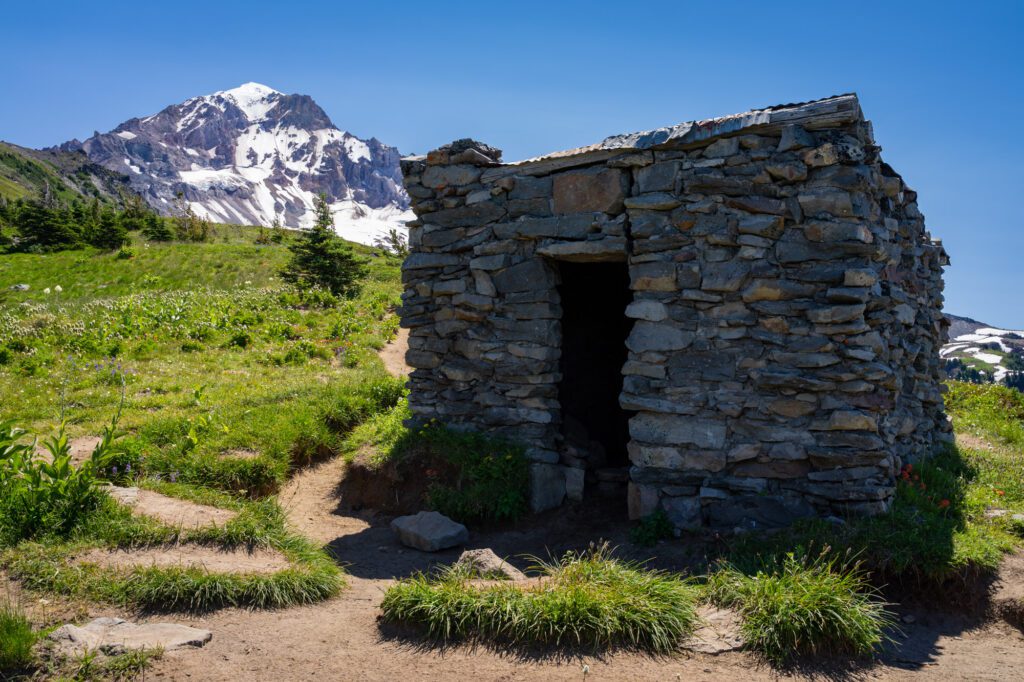
There are a bunch of amazing hikes near Mount Hood, and it’s going to be hard to choose just one to tackle on your day trip.
Not a bad problem to have, really.
Here are our picks:
If you want a gorgeous waterfall, hike to Ramona Falls. Rather than being about the huge drop, Ramona Falls cascades down, creating a spider web of running water (that’s also very, very high, to be fair).
If you want a moderate hike with outstanding views, do Timberline Lodge to Zigzag Canyon.
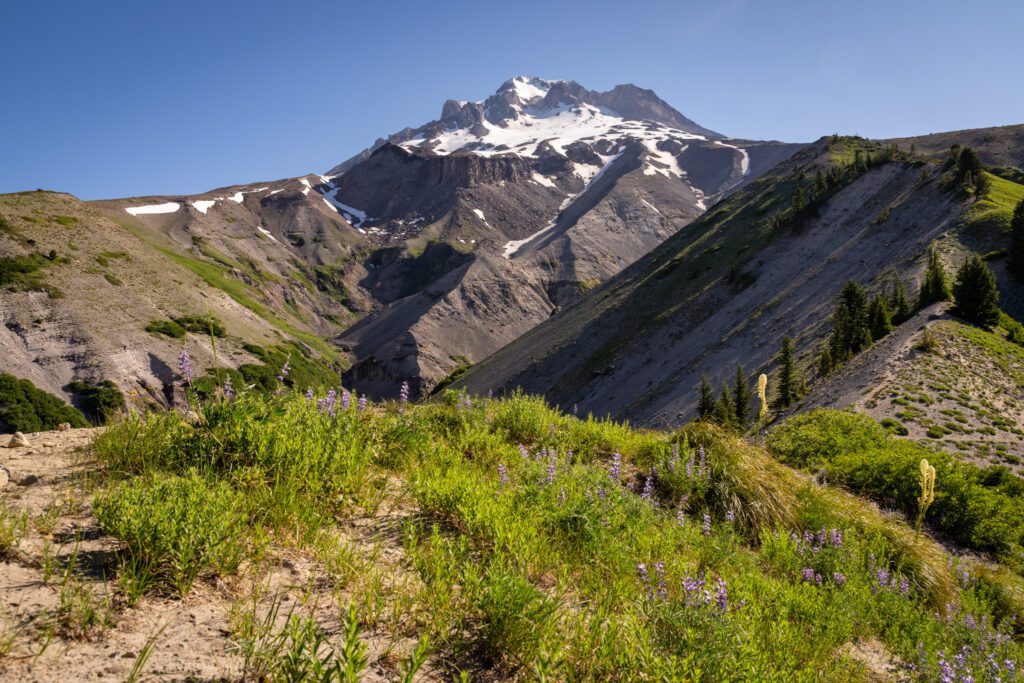
First of all, you’ll get to check out Timberline Lodge, a historic lodge that’s fun to poke around.
Second of all, you’ll hike through the ski lifts, which is fun. Last, the view of Mount Hood from Zigzag Canyon is amazing.
If you’re up for a long hike and want our favorite hike at Hood, do McNeil Point.
This hike is HARD. So hard that Alysha has a strict “once every five years” policy for it.
But the views of Mount Hood on the way up and at the grand finale of the hike are unforgettable.
Add in the great views of St. Helens, Adams, and Rainier, and the wildflowers in the early summer, and you’ll understand why it’s one of our favorite hiking trails in Oregon that we’ve ever done.
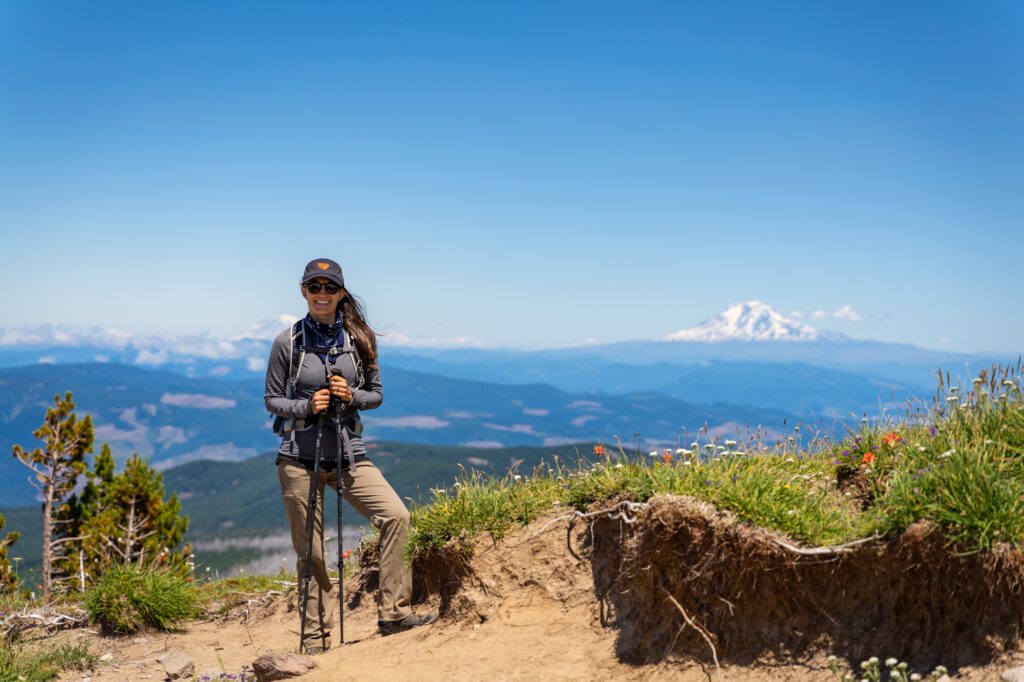
Again, it’s a hard one. Not for the novice hiker. Bring lots of water, snacks/lunch, and sun protection.
We have an entire guide dedicated to hiking the McNeil Point Trail – including logistics like which route to take, and a complete trail guide – which you should read for more detail.
Other Things to Do Near Mount Hood
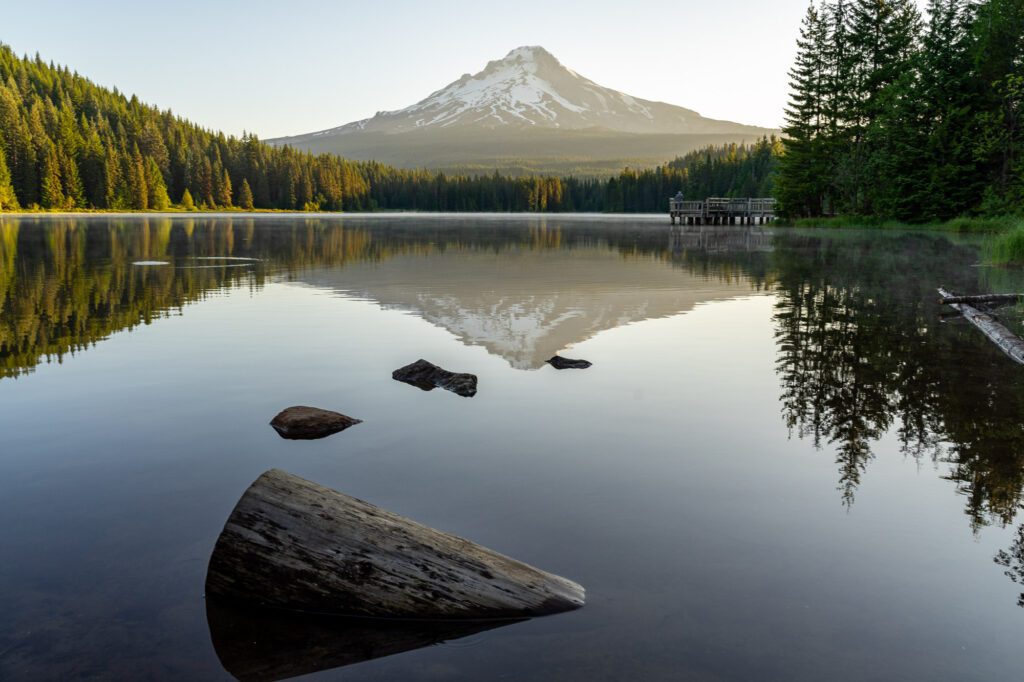
Other than hiking, there are a few other stops to make around Government Camp, which for all intents and purposes is the center of all the action.
For a post-hike beer, head to either Mount Hood Brewing or Ratskeller right in Government Camp.
For a picture-perfect view of Mount Hood’s reflection, head over to Trillium Lake and walk along the shore of the lake to the south end of the lake.
This is one of our favorite views in the state, and is a good place to bring a beer at sunset to watch Mount Hood’s peak glow pink as the sun dips and the alpenglow sets in.
In the winter, Mount Hood becomes a great ski destination, and at 90 minutes from downtown Portland, it’s hard to beat in terms of convenience from the city.
We head up to Mount Hood just about every winter now, and we like Mount Hood Meadows the best out of the various resorts.
Hood River
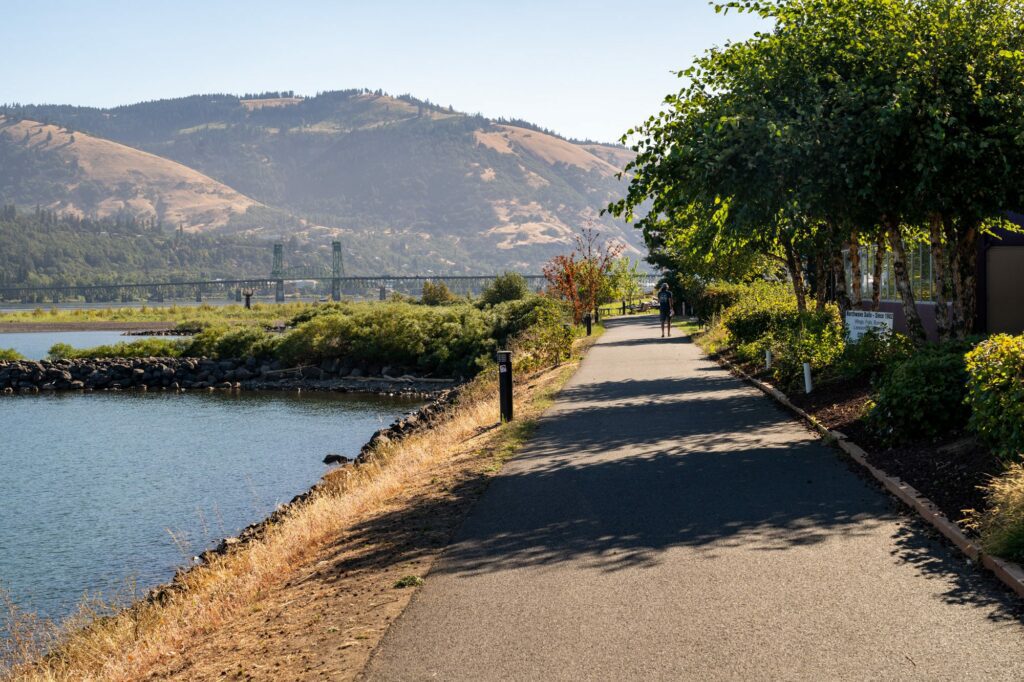
Distance from Portland: 62 miles || Drive Time from Portland: 1 hour 15 minutes
Hood River is another really easy day trip. It sits along the Columbia River, about 60 miles up the Gorge from Portland, and sits roughly at the point where the terrain transitions from lush to high desert.
It’s a great example of the incredible diversity of the landscapes in Oregon (and Washington State), because in every direction you’ll find something slightly different.
To the north, you’re going to be heading into the Cascades, with St. Helens and Mount Adams looming over Hood River.
To the south is the lush Hood River Valley, the fruit basket of northwest Oregon.
To the west is the greener part of the Gorge, and to the east is the high desert, the dry part of the Gorge.
We’d split your time in Hood River into two parts.
The first part should be getting lunch in town (and a local beer, perhaps at the same time) and the second part should be exploring the Hood River Valley, which is just south of Hood River and is one of the most fertile patches in Oregon, with apples and pears growing as far as the eye can see.
It’s worth noting that these first two (the Gorge and Hood River) make a nice combination, because to get to Hood River, you have to drive through the Columbia River Gorge.
It makes sense to spend the morning exploring the Gorge, land of the countless towering waterfalls, and then spend the afternoon in Hood River, which is a nice town just up the Columbia from Portland with plenty of craft beer, cider, food, and a fertile valley waiting for you to explore (and fresh fruit to enjoy, depending on the season).
If you’re combining the Gorge and Hood River, after a morning in the Gorge head into Hood River, passing by the windsurfers out on the river (this is one of the best spots in the country for windsurfing thanks to the wind that comes whipping down the Gorge).
What to Do in Hood River
Here are some things we enjoy in Hood River.
Hang out in Downtown Hood River
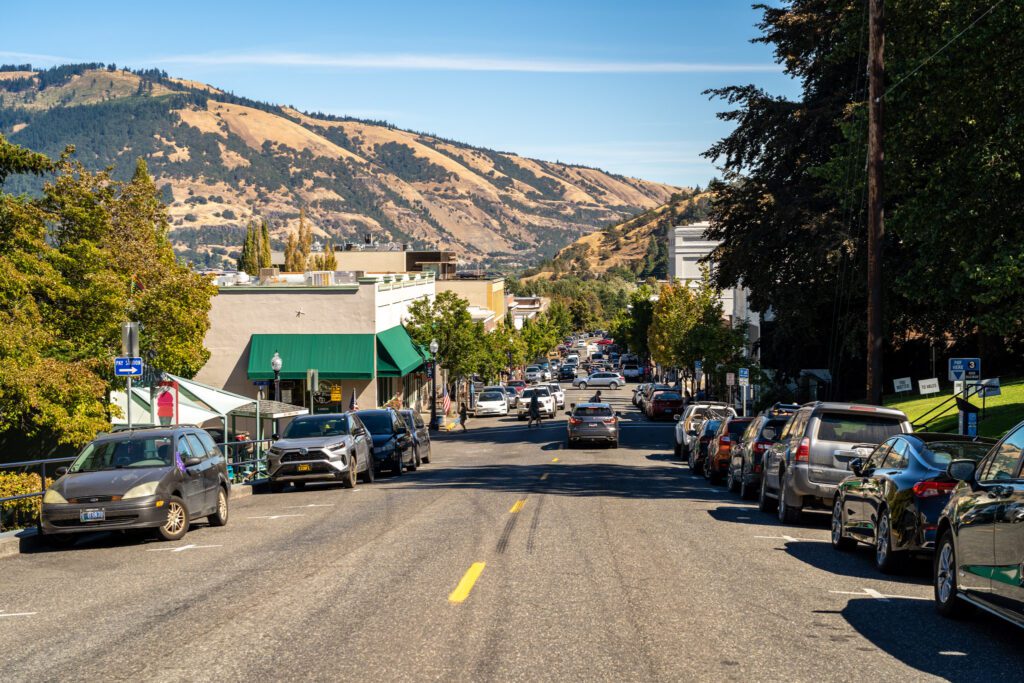
Hood River itself is a fun little town, full of places to eat, drink, and shop.
For beer, you have a bunch of classic Oregon craft breweries – we’d head to either Full Sail or pFriem.
For cider, head to Crush Cider Cafe.
For food, head to Broder Ost for brunch or lunch, Grasslands Barbecue for amazing Texas-style barbecue, or across the river to White Salmon and Pixán Taqueria for great tacos and tequila.
Drive the Fruit Loop in the Hood River Valley
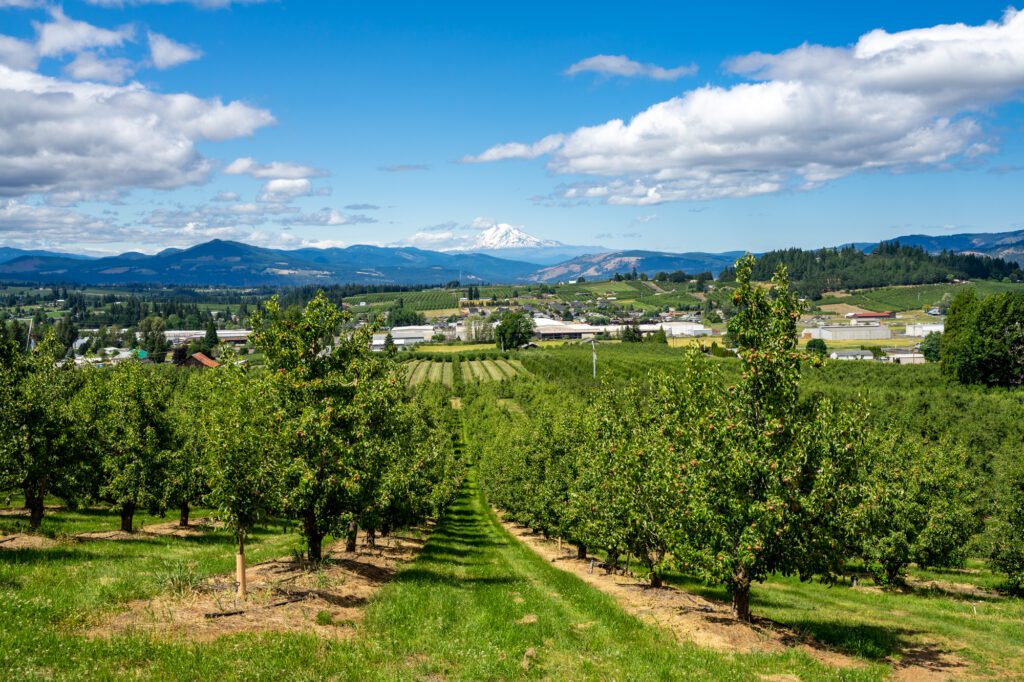
In the Hood River Valley, here are some can’t-miss stops. A good resource for this part of the world is the Fruit Loop, which is both a delicious breakfast cereal, and also a beautiful drive through the Hood River Valley.
Stave and Stone: We like the location of their tasting room at the vineyard.
Hood River Lavender: A lavender farm with a view of Mount Hood’s peak? Sounds good to us. U-pick lavender during the summer, from June to September.
Draper Girls Country Farm: Fruit, cider, and a bunch of fun gifts like local jams and spreads. We always stop here if we’re in the neighborhood, and depending on the season you’ll find apples, cherries, and more.
The Gorge White House: A lovely place to spend an afternoon. They have cider, wine, and u-pick fruit in the summer with beautiful grounds that are just begging for a picnic.
Take a Hike
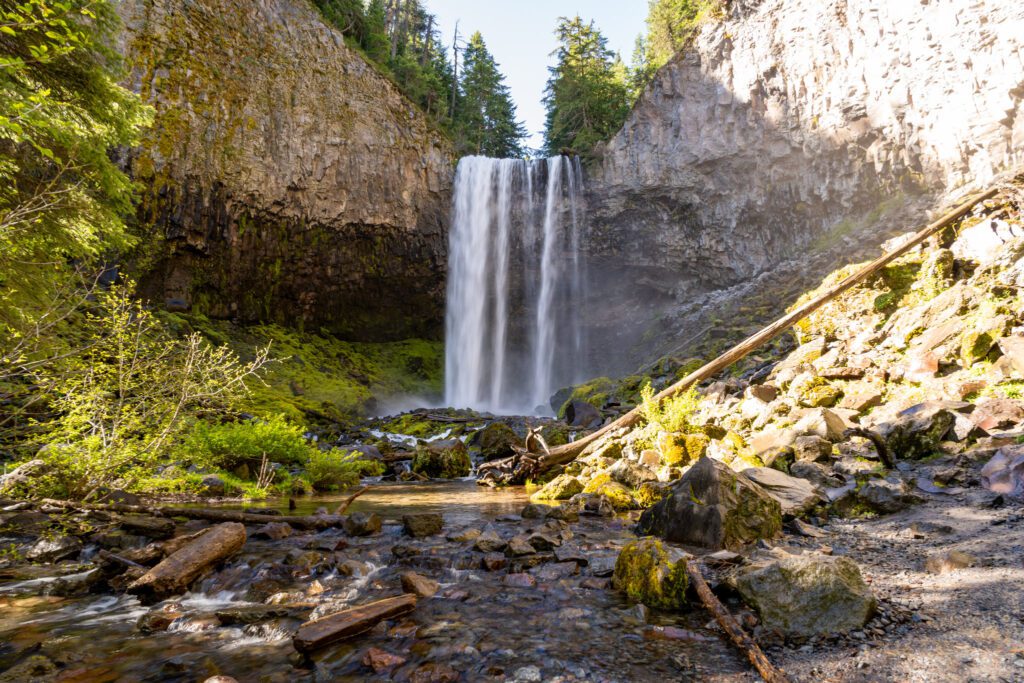
There are a bunch of great hikes near Hood River, including the ones we already mentioned above in the Gorge that are on the way out to Hood River.
You could also head south to Tamanawas Falls on the eastern flank of Mount Hood, or just across the river to Coyote Wall to get up on the ridge line on the Washington side (with great wildflowers in the early summer!).
Get Out on the Water
Hood River is known for water sports. It’s one of the best windsurfing destinations in the country, and even beginners can get in on the action.
Head to Big Winds for rentals and lessons. Or, if you’re not so into windsurfing, then get out on a kayak or stand up paddle board instead, which you can rent here.
Tillamook & the Three Capes Scenic Route
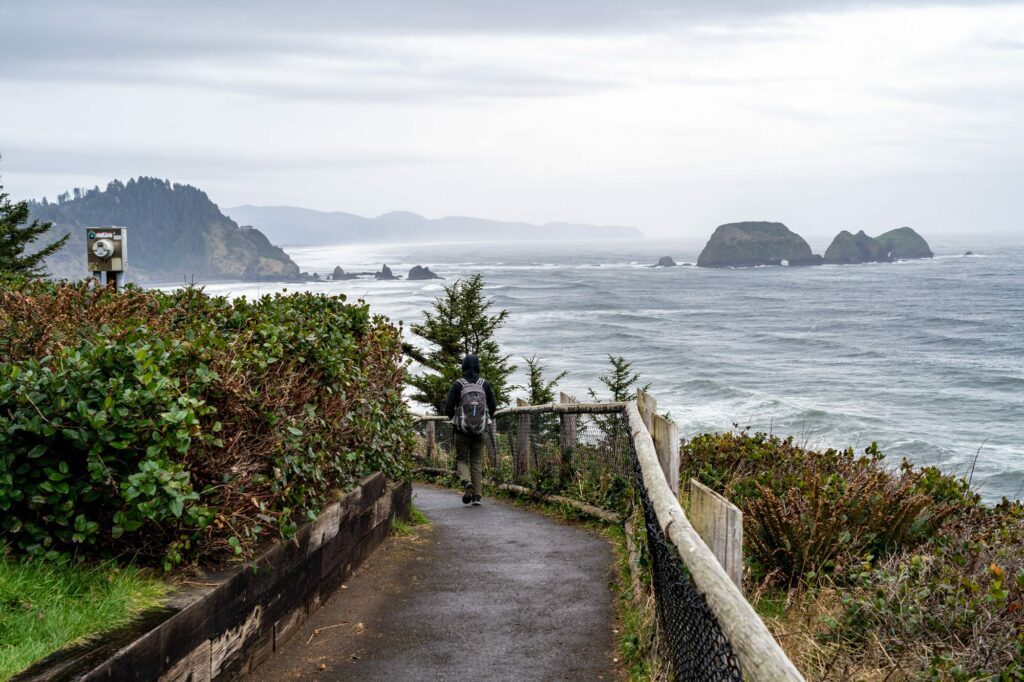
Distance from Portland: 75 miles || Drive Time from Portland: 1 hour 20 minutes
Cannon Beach is arguably the most famous destination on the Oregon Coast, while Astoria is the most significant in terms of Oregon history.
Tillamook is most famous for its cheese and ice cream production – everyone who grows up in the Pacific Northwest has crowded around a tub of their chocolate peanut butter ice cream on a warm summer evening – but there’s a lot more to see in and around Tillamook (mostly around) that warrants a full day excursion out here.
We’re definitely not saying that you shouldn’t stop in at the Tillamook Creamery – you absolutely should – but we are saying you should spend a little more time exploring the surrounding area.
It’s also worth noting that you could combine this with Cannon Beach to make a little loop, starting with Cannon Beach in the morning, and making your way south to Tillamook for the afternoon before you make your way back to Portland.
What to Do Around Tillamook
Here are our favorite things to do near Tillamook.
The Tillamook Creamery
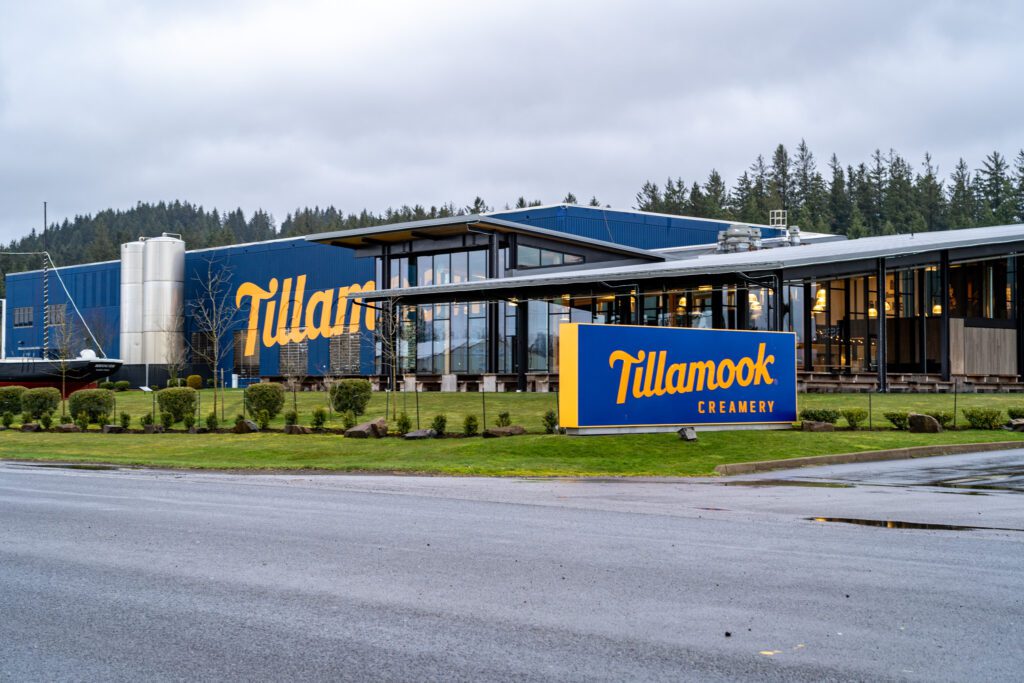
I mean, you kind of have to visit the Tillamook Creamery if you’re nearby, right?
Alysha LOVES the ice cream here, and they have a scoop shop with more flavors than I’ve ever seen anywhere else.
Plus, cheese curds that are only available here at the creamery.
Inside the big building, there’s a self-guided tour of the factory, a big gift shop with Tillamook products and other locally made items, and the aforementioned scoop shop.
They also have an onsite restaurant, which would be a good lunch stop (the tomato soup + cheese curds is a classic, especially on a drizzly day).
Blue Heron French Cheese
Just down the road from Tillamook, there’s a smaller, less famous cheese company that’s also worth a visit.
They focus on French cheese (lots of brie!), and have a fun shop with other products like charcuterie and jams and jellies to pair with their cheeses. Plus, an onsite deli for lunch.
Drive the Three Capes Scenic Route
The Three Capes Scenic Route is one of the most scenic drives in Oregon, and it heads south out of Tillamook to hit – you guessed it – three capes along the coast.
This is pretty clearly one of our favorite stretches of the Oregon Coast, with spectacular views and wide sandy beaches throughout the entire route.
Cape Meares is your first stop, and there are two things to check out. First is the Cape Meares Lighthouse, which is the shortest lighthouse on the Oregon Coast.
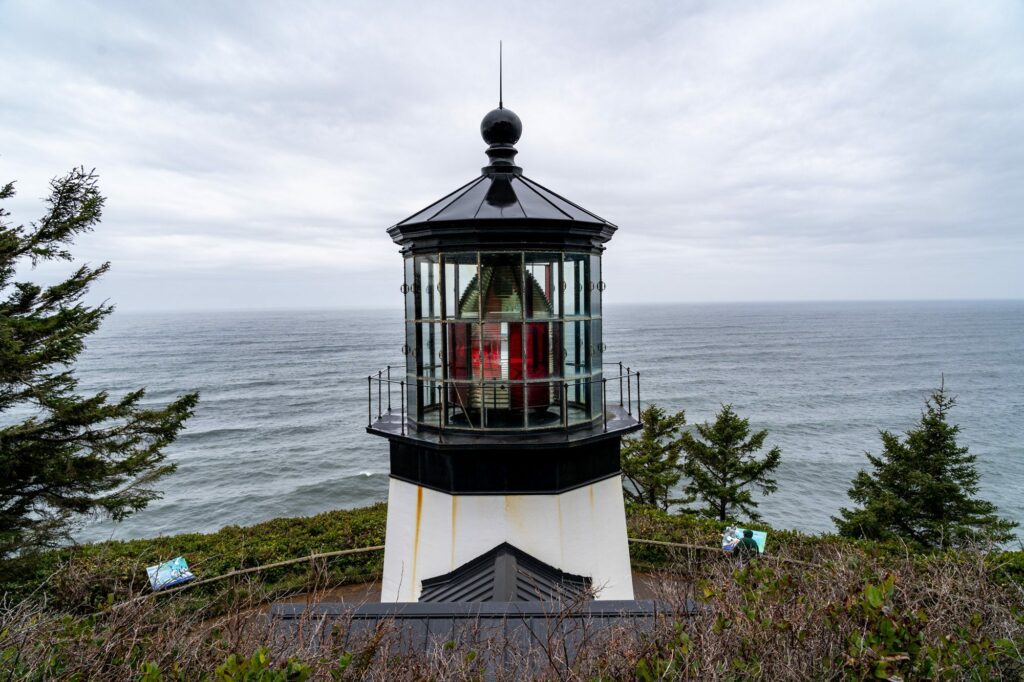
However, it has an impressive lens that was installed in 1890.
The second thing not to miss is the Octopus Tree (it’s a weird looking tree with eight branches, hence the name) and the viewpoint right past it that looks out over the beaches to the south, including Short Beach. It’s a short walk from the main parking lot.
Cape Lookout is your next stop, and is our personal favorite of the three. The highlight, by far, is the hike out to Cape Lookout.
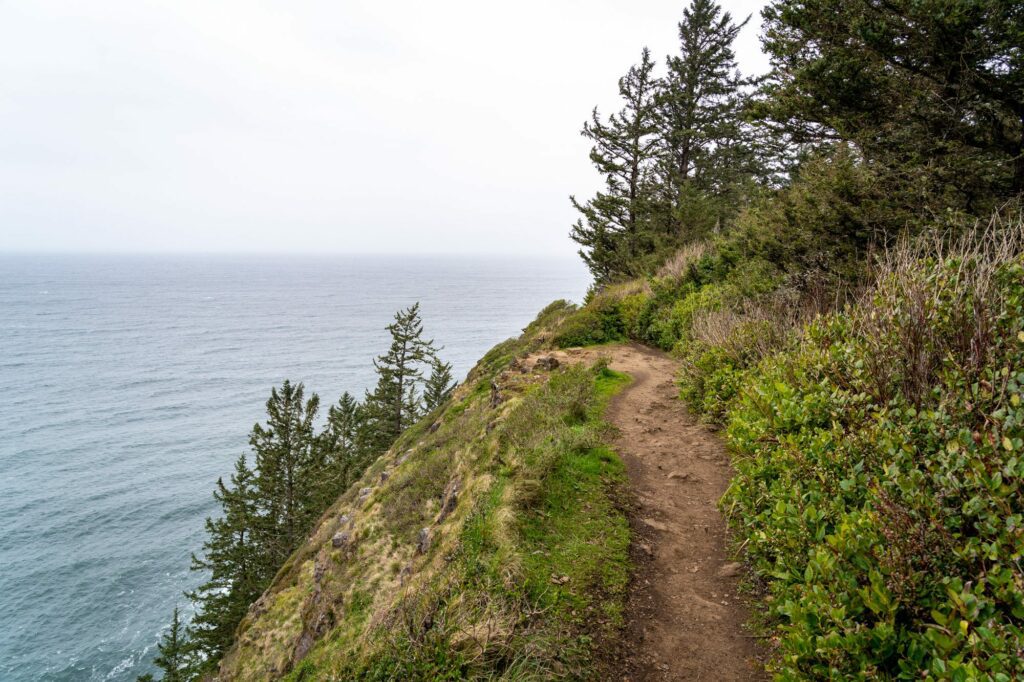
It’s a relatively easy hike that hugs the cape, which narrows as you get further and further out onto it before the trail ends at its western tip, where the views are amazing and you can hear the seals frolicking on the rocks below.
It’s also a good place for whale watching in spring, because it’s about as close to the migrating mammals as you can get.
Cape Kiwanda is the last of the three capes, and it’s a little different. It’s very popular with surfers, and you can drive out onto the beach, which means it’s a slightly different crowd that includes fishermen and boaters.
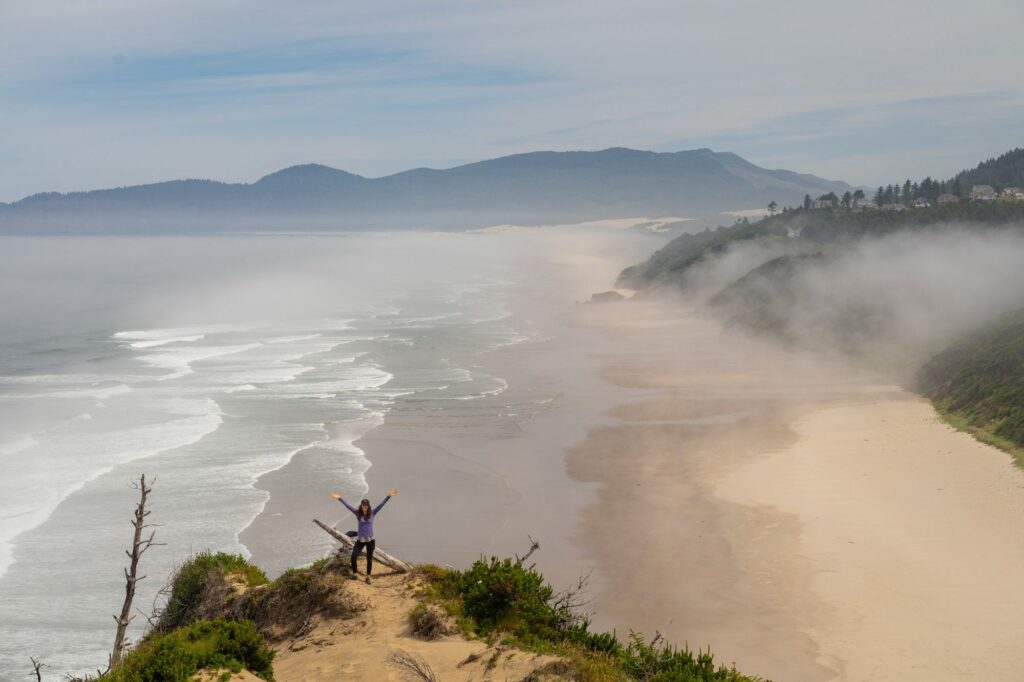
From the parking lot, the main attraction is up and to the right of the beach, where you can hike up onto the cape for some great views in both directions.
You’ll be hiking up in deep sand, so it’s harder than it looks. Make sure to catch the hang gliders, if they’re out, who use the northern end of the cape as a jumping off point.
Hiking in Tillamook State Forest
On your way out to Tillamook, you’ll drive along Highway 6 through Tillamook State Forest.
There are a couple of nice hikes right off of the road, like University Falls (on the easier end of the spectrum) and King’s Mountain and Elk Mountain (on the “why did I do this to myself” end of the spectrum).
Cannon Beach
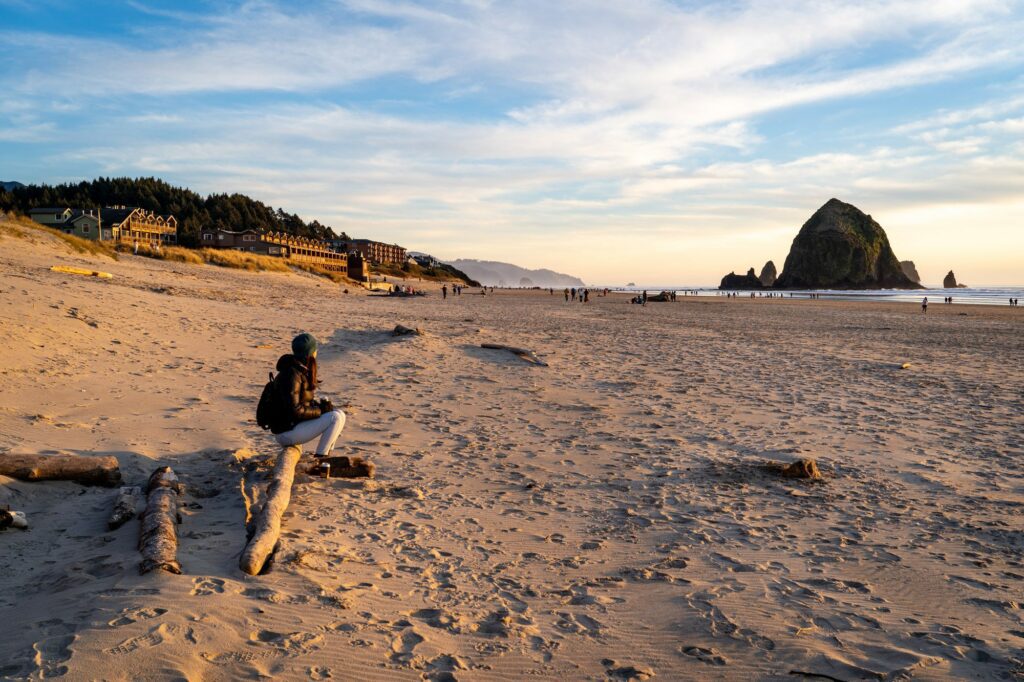
Distance from Portland: 80 miles || Drive Time from Portland: 1 hour 30 minutes
Is Cannon Beach itself our favorite destination on the Oregon Coast? No, probably not.
However, the reason it belongs on this list is the proximity to two of Oregon’s best state parks, which sandwich Cannon Beach between them. They are Ecola State Park and Oswald West State Park.
It’s worth your time, and there’s plenty to do to fill an entire day.
However, you can also absolutely combine a trip out to Cannon Beach with a trip to Astoria, and make one big loop that sees the highlights of the northern Oregon Coast.
What to Do in Cannon Beach
There are four broad categories of things we think are worth doing in Cannon Beach. We’ll organize them from north to south, and you can do them in that order, or in the reverse.
We’d recommend starting at Ecola though, because it gets pretty busy on weekend mornings.
Explore the Beaches at Ecola State Park
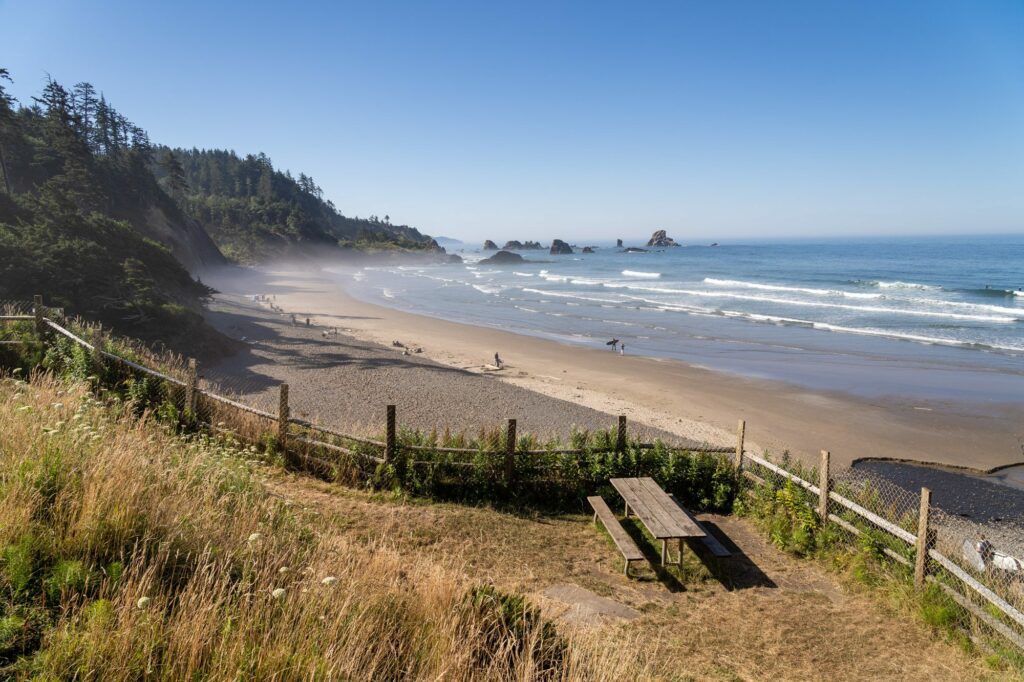
Your first stop just north of Cannon Beach is exploring Ecola State Park, which had been closed for a couple of years until recently because of storm damage.
As you drive the forested, ferny, winding road out to the park, you’ll immediately understand why that was the case.
We’d stop at the first parking lot for the views and a walk out to Crescent Beach, then head to the second parking lot and hike the Clatsop Loop Trail and take a walk on Indian Beach, which is right below the parking area.
Wander Around Cannon Beach
The next two stops are in Cannon Beach itself. We’d find parking in town, and stay parked there for the duration of your stay in the downtown area. It can be tough to find parking on weekends around midday, so you may have to wait.
For your second stop of the day, explore the town of Cannon Beach. The downtown area isn’t particularly big, and you can basically walk around it in 45 minutes, give or take.
In between the somewhat touristy shops and restaurants, there are a few gems that are worth your time.
For coffee, go to Insomnia. For local beer and fish and chips – including Celiac-safe gluten free food options – go to Public Coast Brewing.
Cannon Beach Book Co. is the local bookstore (that you should support!), and Suzy’s Scoops is a good stop for ice cream.
Admire Towering Haystack Rock
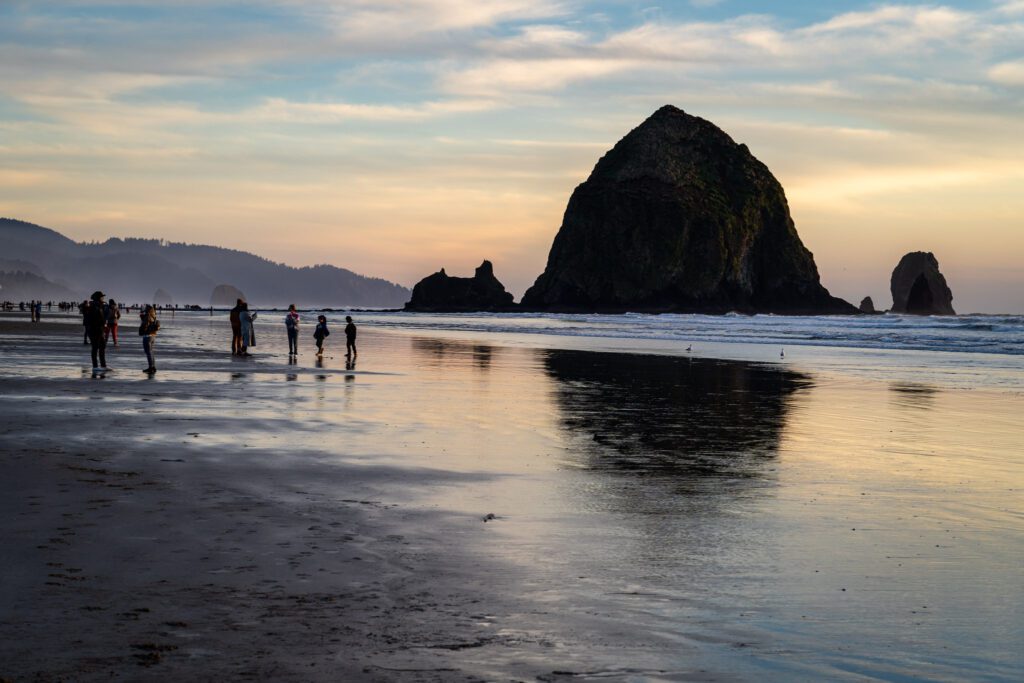
Your third stop is Haystack Rock, which is probably the most famous landmark on the Oregon Coast and rises 235 feet out of the Pacific Ocean, towering over Cannon Beach.
We also really like coming here for sunset, and if you’re around that late, we’d highly recommend heading out there.
Don’t miss the puffin colony on the rock – our first trip here, we got to witness a pair of bald eagles stealing puffin eggs, which the puffins were (understandably) not happy about.
Hiking in Oswald West State Park
After you’re done in Cannon Beach, continue south out of town, stopping at Silver Point for a nice view of the beach, and continue to Oswald West State Park.
If you’re up for a hike, head up to the top of Neahkahnie Mountain, a tough hike with excellent views at the end.
Then head out to Short Sand Beach, which is accessible by a short easy walk through the woods.
Astoria
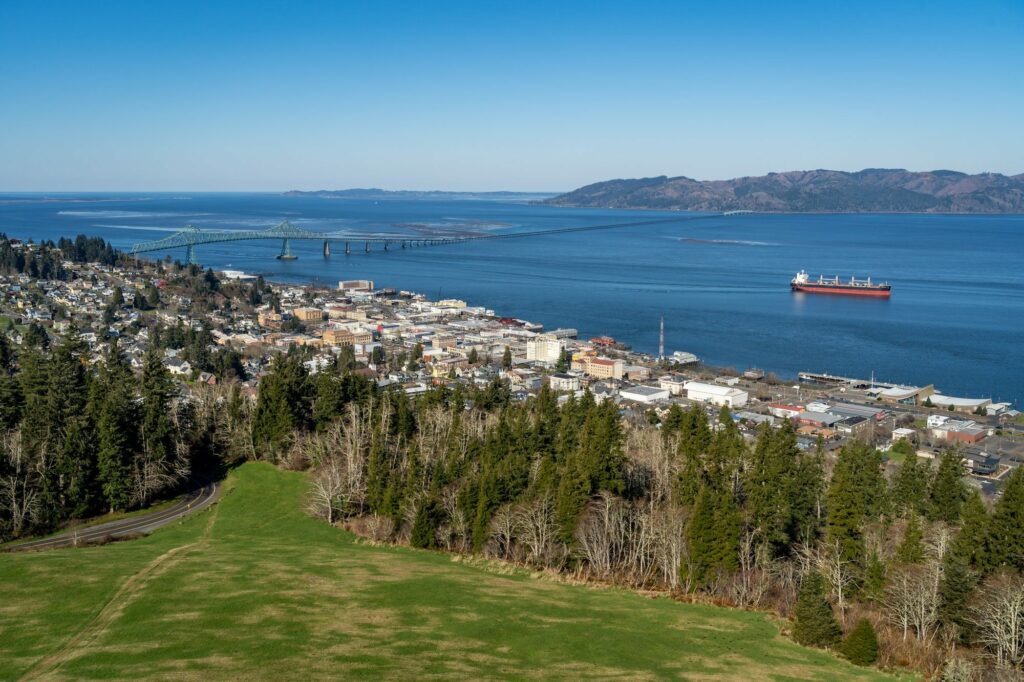
Distance from Portland: 97 miles || Drive Time from Portland: 1 hour 30 minutes
Astoria is a charming little town at the northwestern corner of the state with a surprising amount of things to do, see, eat, and drink.
It’s also full of history, as it’s the point where Lewis and Clark reached the Pacific Ocean and camped for three months.
We always get a kick out of the fact that they arrived in the dead of winter and basically spent three months sopping wet. They must have HATED it out west.
Similar to the relationship between the Gorge and Hood River, you can do a pretty great day trip that starts in Portland, heads west to Cannon Beach, and loops north to hit Astoria before heading back to Portland.
It’s a lot of driving, but you’ll get to do a really nice loop of the northern Oregon Coast that might be worth it if you’ve got limited time in Oregon (aka you don’t live here).
What to Do in Astoria
We have an entire guide dedicated to our favorite things to do in Astoria, so you should absolutely read that if you’re planning a trip out there.
Here are the highlights.
Lewis and Clark National Historical Park
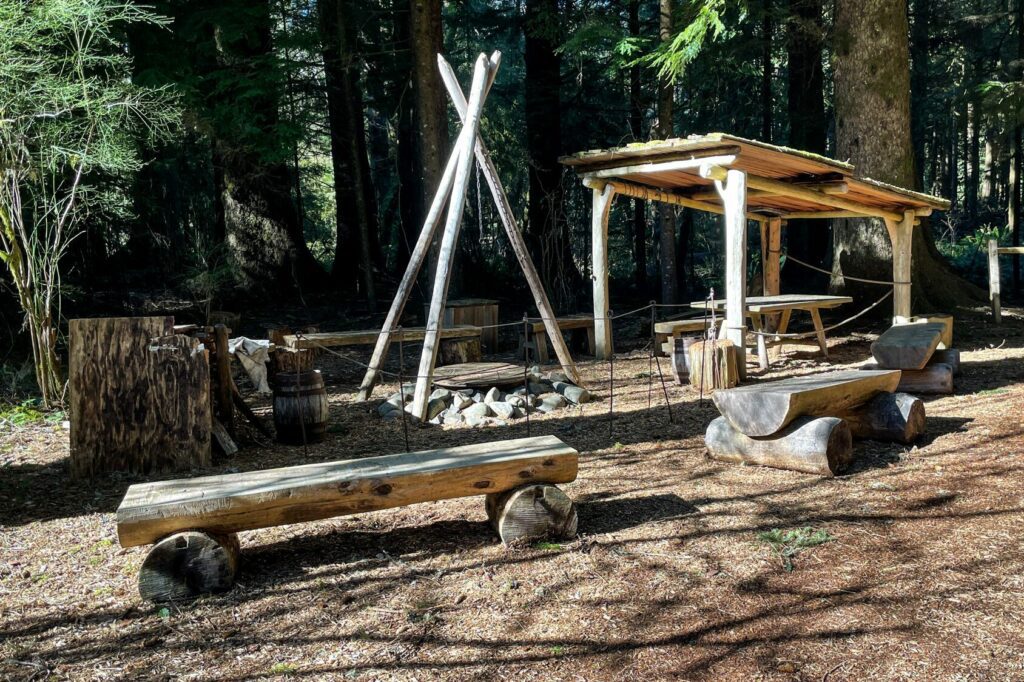
This is close to the site where Lewis and Clark spent a very dreary Oregon winter before deciding to head back to the Midwest, their mission to find the water passage to the Pacific complete.
We laughed when the friendly docent at the visitors center told us how the explorers arrived in the area in November, and spent three rainy months here.
They must have thought that Oregon sucks, heading back to Missouri with a smug sense of superiority.
Turns out, they were very, very wrong about that. Oregon is the best state in the Union (or at the very least, top three) if you ask us.
The Fort-to-Sea Trail
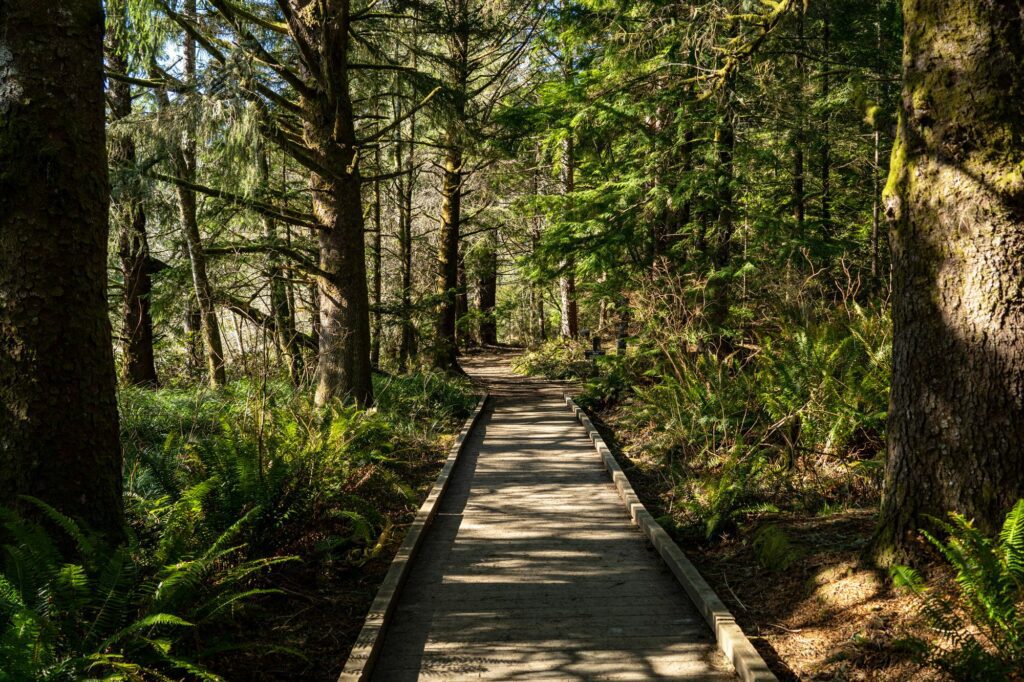
This is a long one-way hike that goes from Lewis and Clark National Historical Park out to the Coast, following a similar route that the explorer’s took to get up to Clatsop Head.
We’d hike the first 1.5 miles of the Fort-to-Sea Trail, which takes you along the path that the expedition used to get between the coast and the fort.
It’s a nice walk through the forest, and while the full 13 mile round trip hike is a little much (especially for a day trip), the first few miles is a nice compromise if you’re short on time.
You’ll end at a point that has a nice view, and make your way back to the park from there.
Fort Stevens State Park
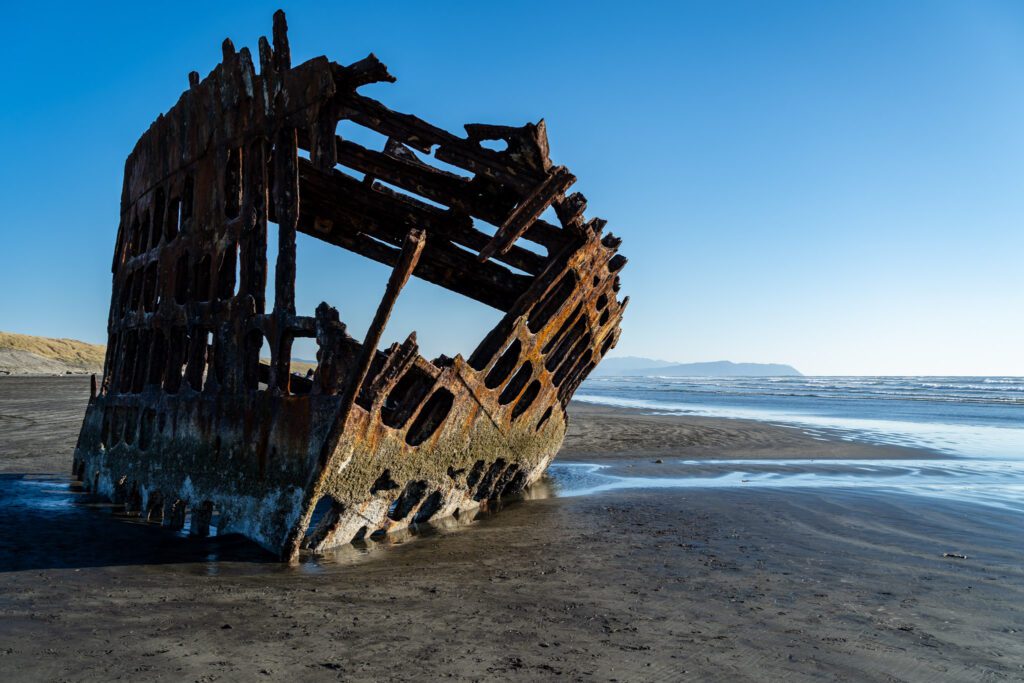
Fort Stevens State Park is the Northwest Corner of Oregon.
There are two places here we’d definitely recommend visiting – the shipwreck of the Peter Iredale on the beach, and the batteries in the northern section of the park.
Enjoy Some of Oregon’s Best Craft Beer
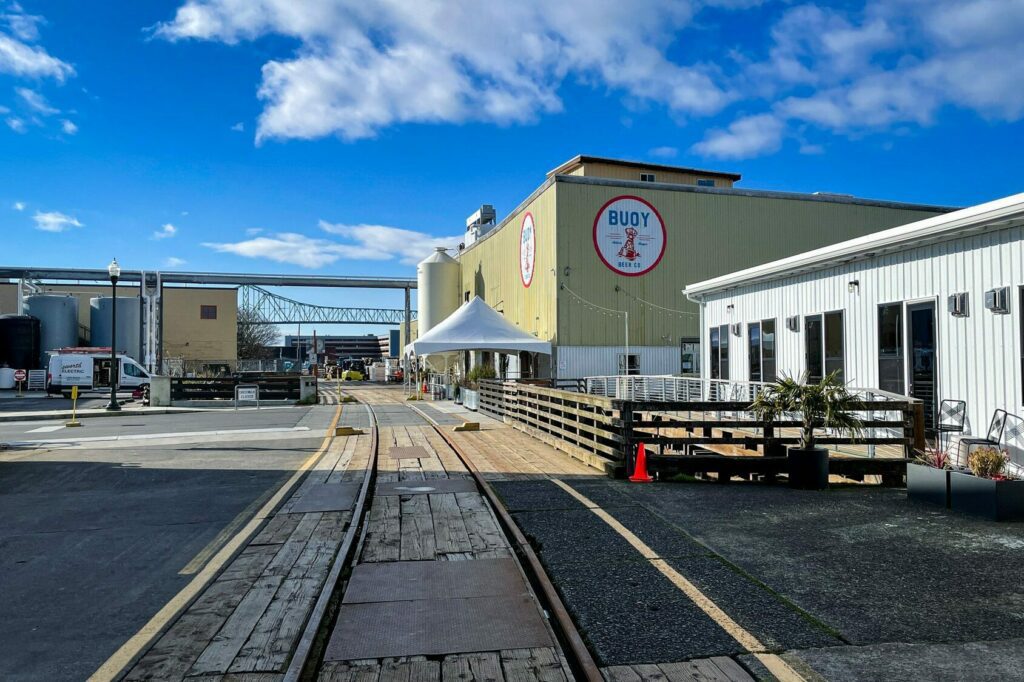
The other thing that Astoria is known for is craft beer.
For whatever reason, there’s a huge number of craft breweries in Astoria. Given the size of Astoria, I think the “craft-breweries-per-capita” number has to put it in the top tier of American cities by that particular measure.
The two main breweries in Astoria are Fort George, which has a big location just off the main drag in Astoria, and Buoy Beer, which is actually on the water.
There are a couple of other ones (namely Astoria Brewing Company the oldest brewery in town), and we’d recommend trying a couple of them (don’t drink and drive, though!).
Learn a Thing or Three at Astoria’s Museums
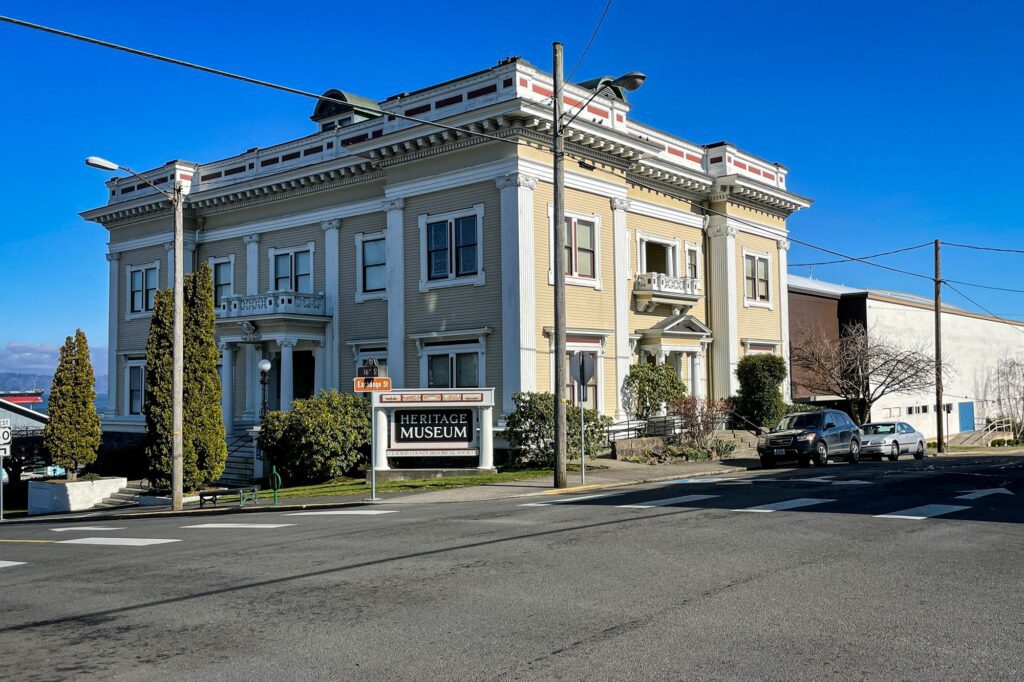
There are also a couple of cool museums in Astoria that serve as a nice history lesson about Astoria’s important role in Oregon’s history.
The two we’d focus on are the Columbia River Maritime Museum, which focuses on Astoria’s role as a main port city at the mouth of the Columbia River, and the Heritage Museum, which is a basically the Astoria history museum and covers the city and area from pre-Lewis-and-Clark through reconstruction and the industrial period.
It’s pretty interesting, and talks a lot about the changes the city has gone through as the main imports and exports of the area changed over time.
Before visiting here, I had no idea Astoria played such a pivotal role in the fur trade, and it prompted me to read Astoria – a tale about (nepo baby) John Jacob Astor who proclaimed Astoria as the New York City of the West Coast and proceeded to flop SPECTACULARLY – which I highly recommend.
Climb the Astoria Column for a Great View
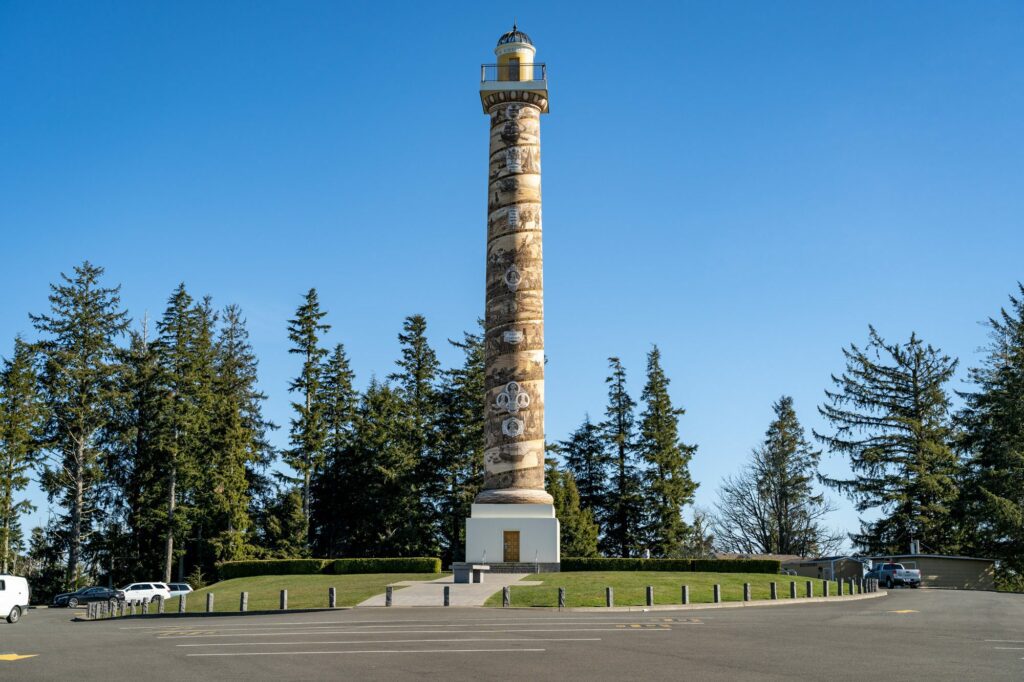
Last, but certainly not least, is the Astoria Column, which is perched on the top of the hill overlooking the city and the famous Astoria-Megler Bridge, is also worth a visit.
You can either drive up to the parking lot – which costs $5 to park at – or hike from town on the Cathedral Tree Trail.
It’s worth climbing to the top of the tower for excellent views (it’s free, minus the parking fee).
Mount St. Helens
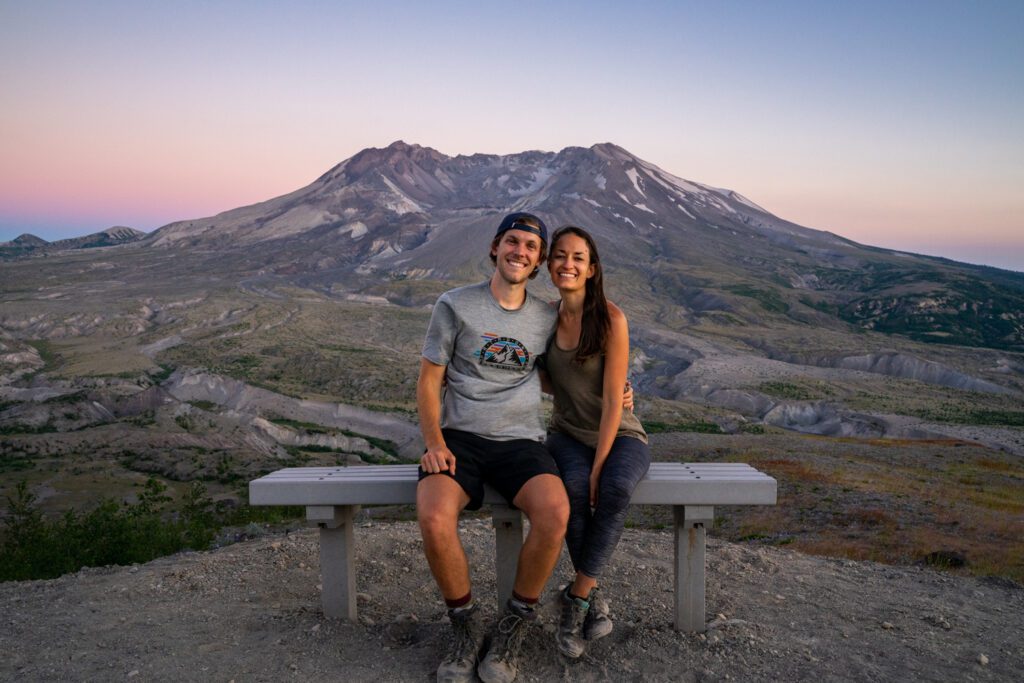
Distance from Portland: 109 miles || Drive Time from Portland: 1 hour 40 minutes
Even though it’s in Washington State, most of the main sights around Mount St. Helens are actually closer to Portland than they are to Seattle, and it’s an excellent day trip to take if you’re looking to blend history (the volcano’s eruption is an important piece of Pacific Northwest history) and cool landscapes.
I remember reading a book back in 4th grade set at Mount St. Helens, where the protagonist in the story is looking for Bigfoot (and SPOILER eventually finds them in the lava tubes under the volcano).
Ever since reading that, I have been fascinated by both Bigfoot (the main hat I wear hiking says “Believe” across the strap, with a picture of bigfoot on the front) and Mount St. Helens.
If you visit the west side of St. Helens, you’ll immediately be taken aback by the barren landscape around Johnston Ridge Observatory. It’s arresting, because you’ll have driven for 45 minutes up a steep, windy road surrounded by lush forests, and then BOOM there’s no more of that.
We think it’s really, really cool, and well worth a visit.
Though it’s a little inconvenient, because there are three areas around St. Helens that we like, and you can’t really do a day trip that encompasses more than one because there’s not a good way to get around the mountain efficiently.
What to Do at Mount St. Helens
This one is kind of a two-for-one, because there are actually two day trips embedded here (and you can’t really do them both on the same day, because it would be 8-9 hours of driving to circumnavigate the mountain).
The two areas that are accessible for a day trip are the west side of the mountain, which is where you’ll find the Johnston Ridge Observatory and is the best area to see the impact of its consequential eruption, and the southern side of the mountain, which is closer to Portland and has a unique cave you can hike down into.
The northeastern side of the mountain is actually our favorite part, but it’s best saved for a longer trip because it’s a full three hours, one way, from the city.
Given the choice between the west and south sides of St. Helens, we’d opt for the west side. It’s the best area to see the bare landscape that the eruption left behind, and it has one of our favorite hikes in Washington State – Harry’s Ridge.
Here are two ideas for how to spend a day trip to Mount St. Helens.
The West Side (Johnston Ridge)
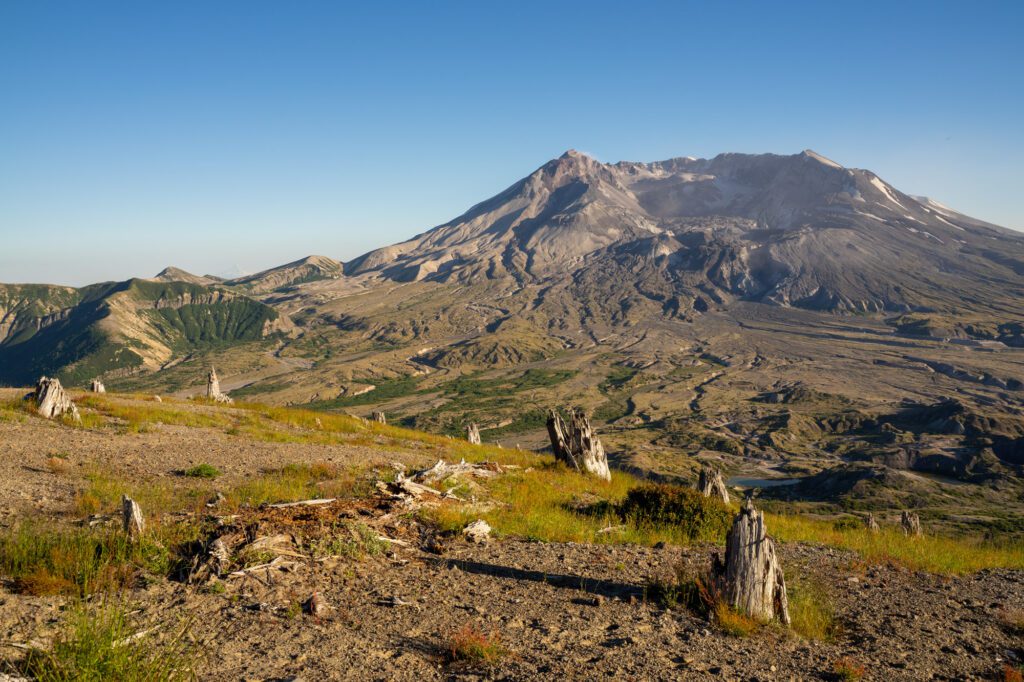
Start your day on the west side of St. Helens by heading straight up to the Johnston Ridge Observatory, which has a lot of great historical and geological information to help give you some context for what you’re looking at (and what you’re about to hike through).
Then, tackle the hike out to Harry’s Ridge, which takes you through the bare landscape out to a bluff with excellent views of the volcano and Spirit Lake, where you’ll see thousands of downed trees sitting on the surface of the lake.
It’s a great hike, and is worth doing even if you can’t make it all the way out to the ridge.
The ever-evolving views of St. Helens’ oddly shaped crown are worth the effort, even if it’s only a mile or two.
End your day at Coldwater Lake, which is just below the Observatory on the drive up. It’s a lovely place for a picnic lunch and a dip in the lake.
There’s a trail along the northern side of the lake, and you could hike along that trail until you’ve had your fill of hiking for the day.
The South Side of St. Helens
On the south side of St. Helens, your number one priority should be the Ape Cave, which is a unique experience where you can hike down into a lava tube, the longest in the continental United States.
It’s only open mid-May through October, and requires advance reservations, which you can make here. Bring a headlamp and proper footwear.
There are some other cool hikes on this side of St. Helens, like the short one out to June Lake, and the Ape Canyon Trail, which has some excellent views of the various mountain peaks in southern Washington / northern Oregon.

I’m loving your site! My family and I are traveling to Seattle & Portland this summer and was researching for things to do. Your site is so informative, and I love the itinerary suggestions! My youngest son has a wheat allergy, so all the info on GF restaurants is super helpful!! I’m definitely going to take him to Petunia’s Pies & Pastries for his birthday treat.
I do have a question though, my son is wheelchair bound, are the hikes to the waterfalls along the gorge (i.e. Multnomah Falls) wheelchair accessible?
Hey Angela! He’s going to LOVE Petunias. If you can go on a weekend, they have the best gf donuts in Portland.
Multnomah is wheelchair accessible to the viewpoint of the falls (which is pretty spectacular), but I think that might be the only one in the Gorge that is. You can go up to the Women’s Forum Scenic Viewpoint and the Vista House, both of which have fantastic views out over the Gorge and are accessible and paved.
Hope that helps!
What waterfall is the waterfall in that section?
Funny enough, it’s Dry Creek Falls, which isn’t even in the waterfall section! I will have to add that to my list of updates to make.